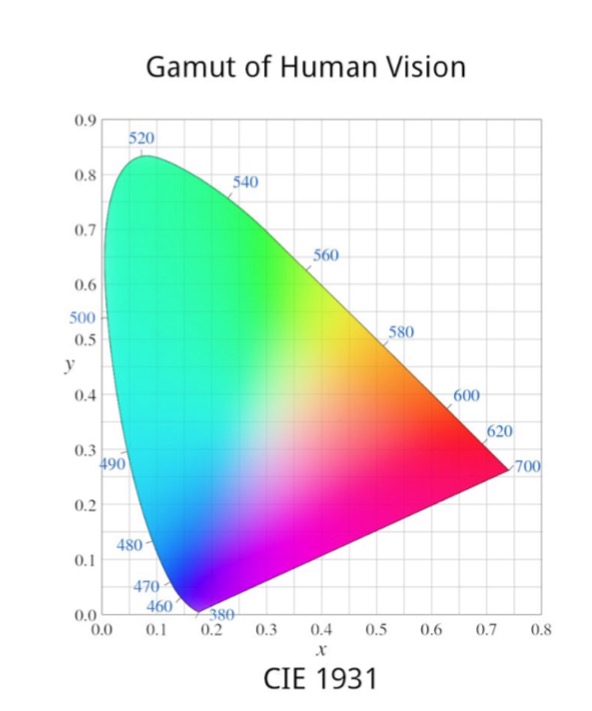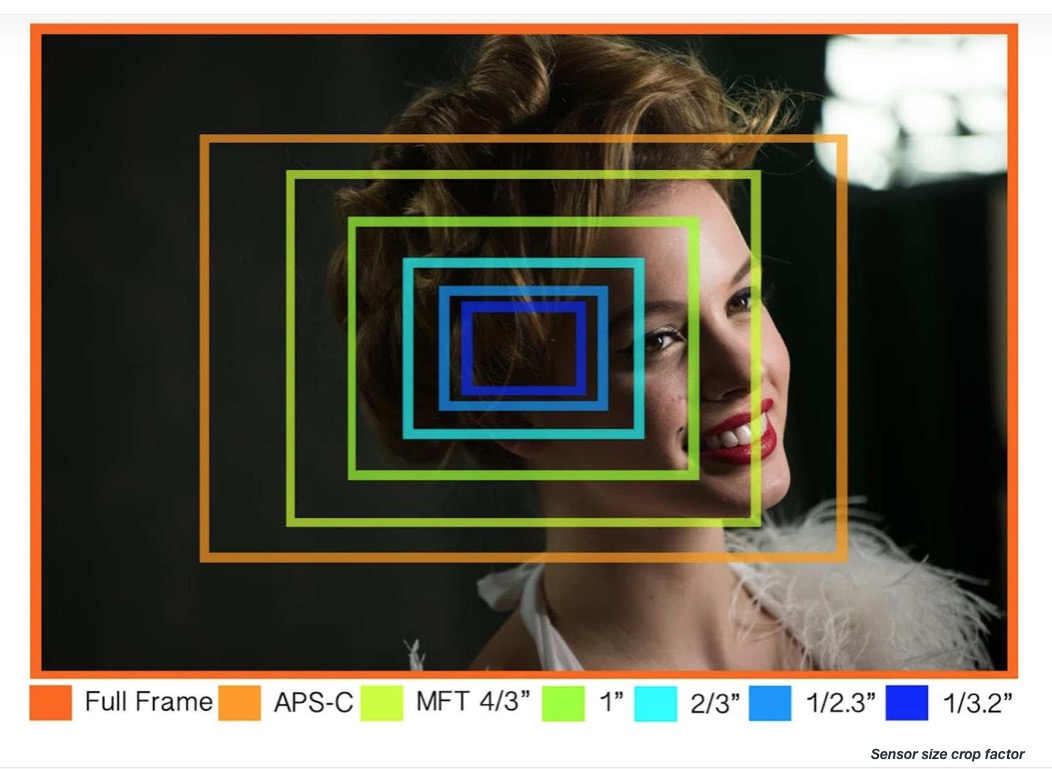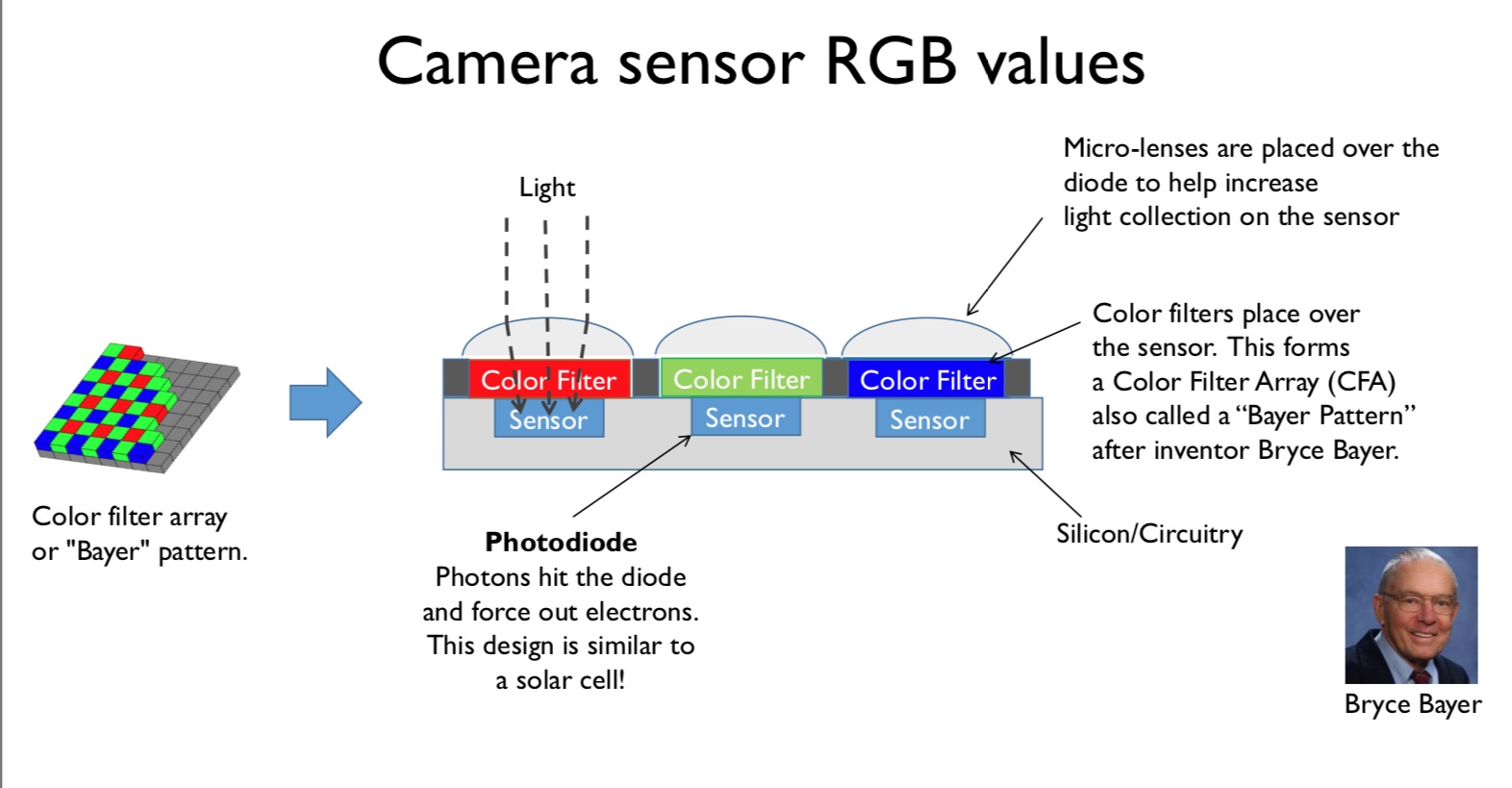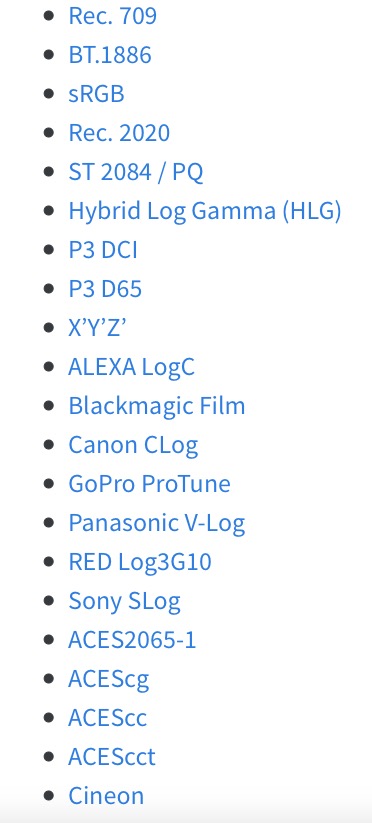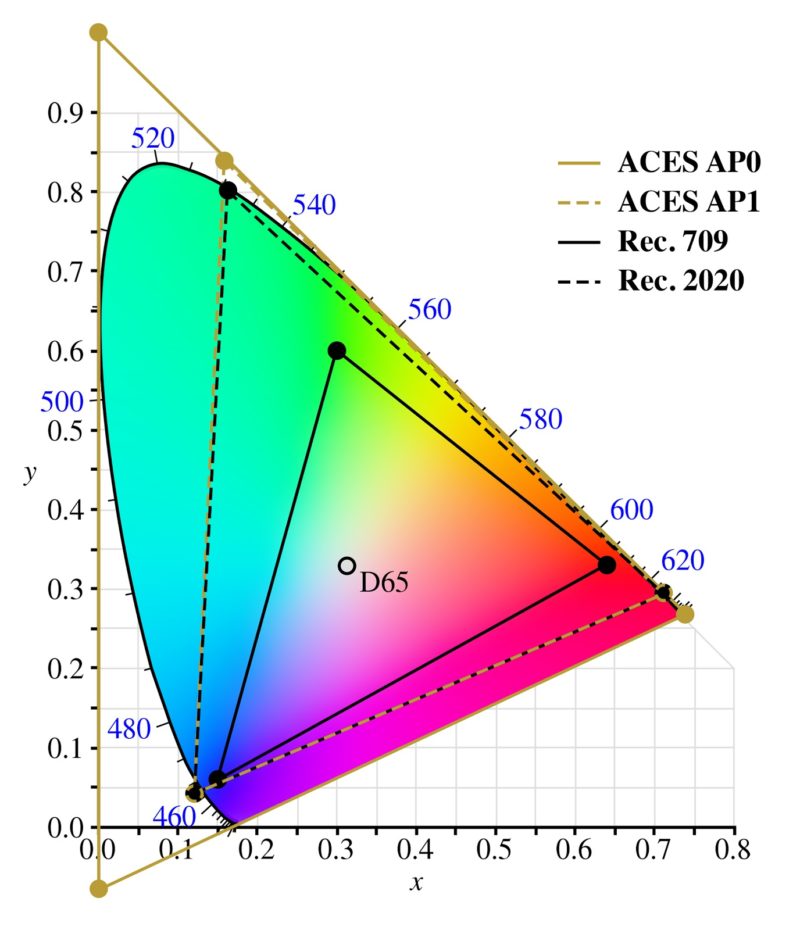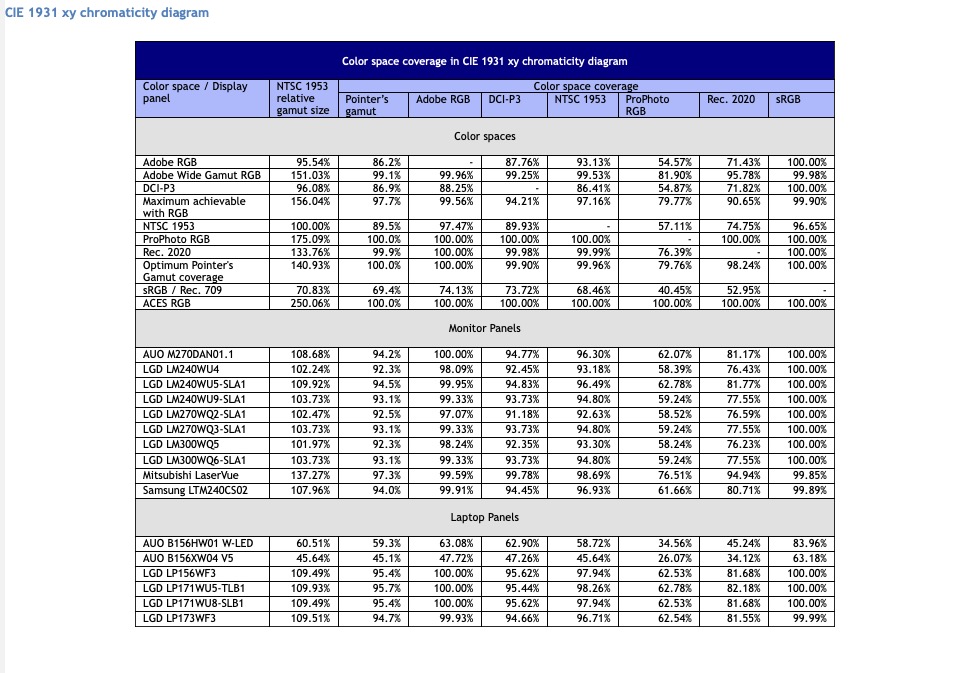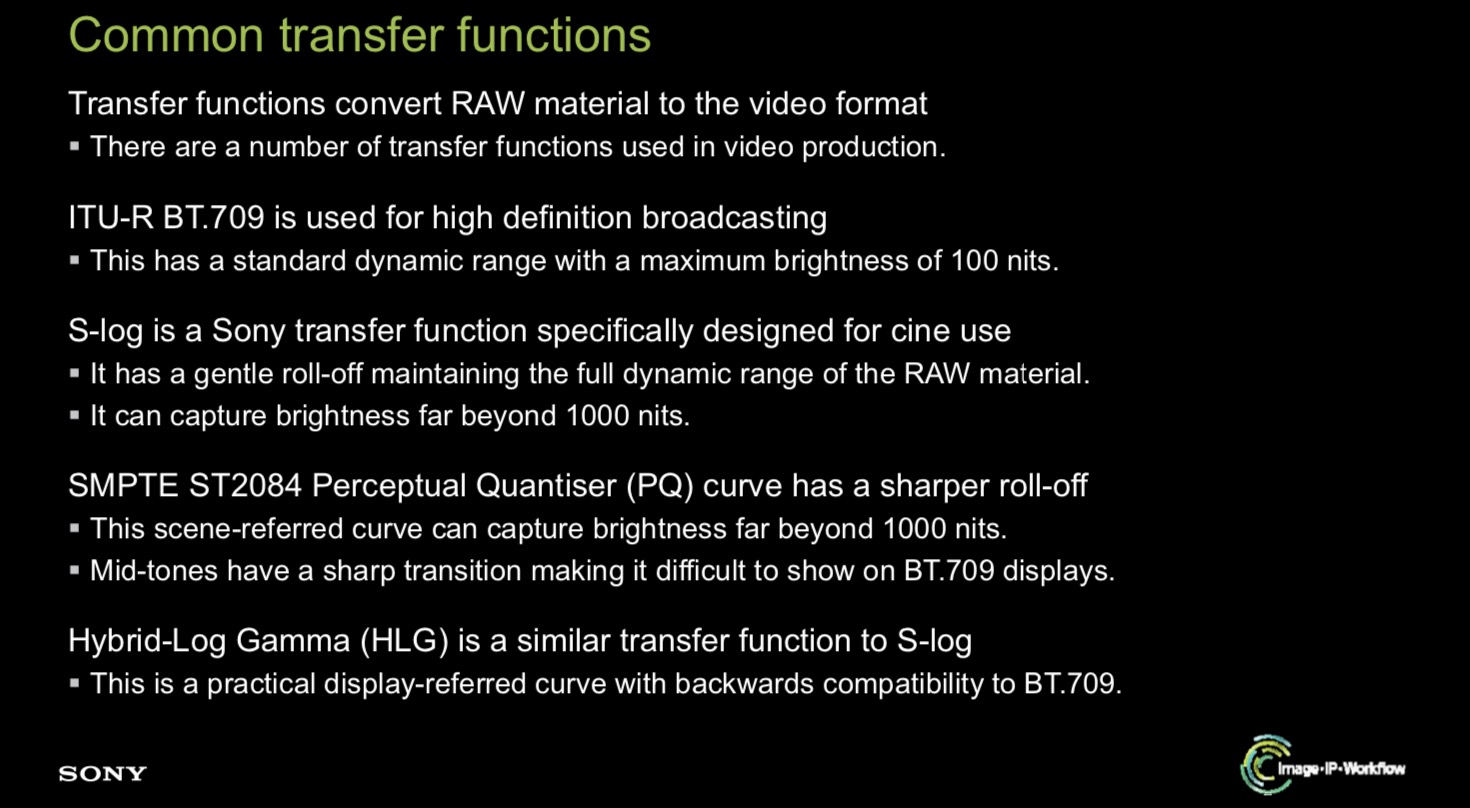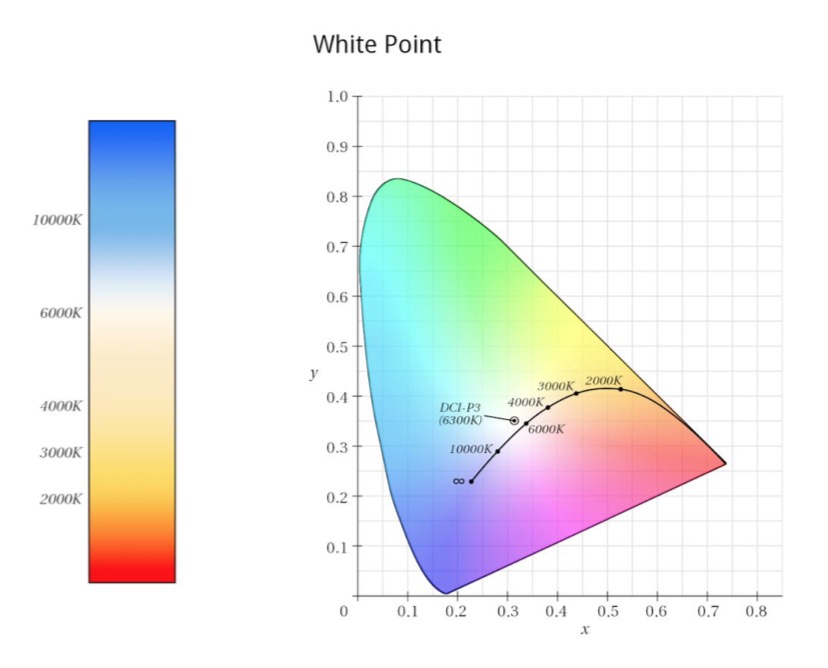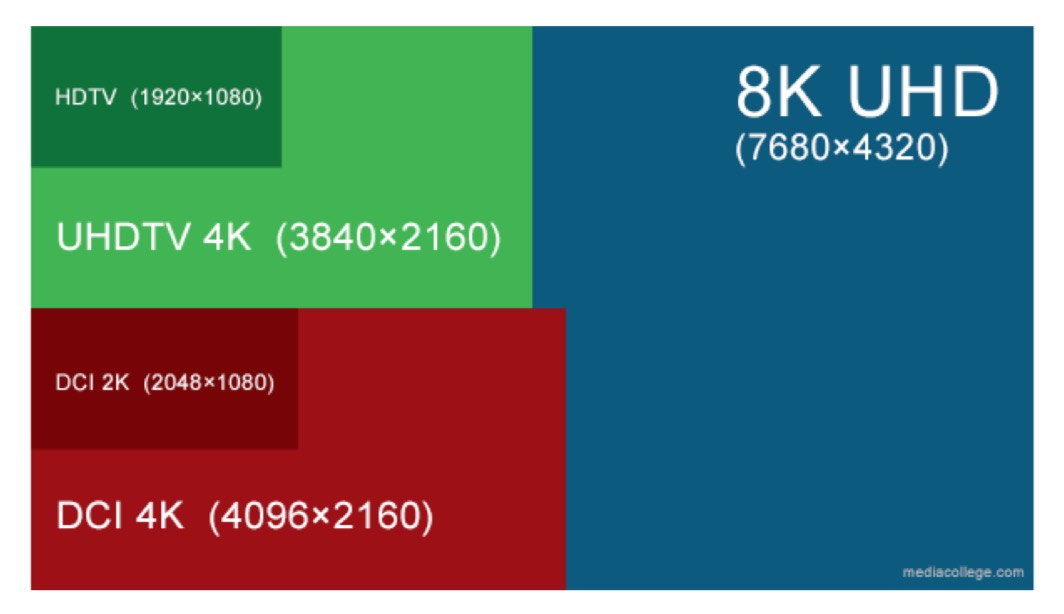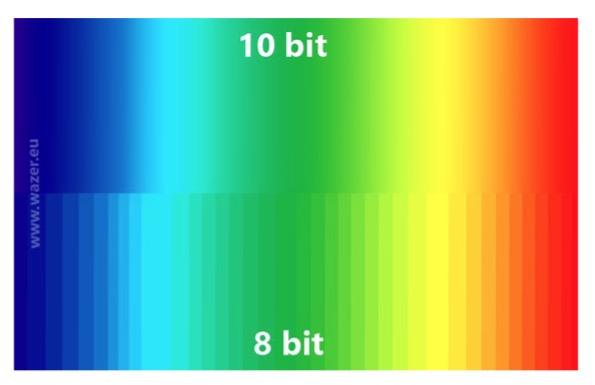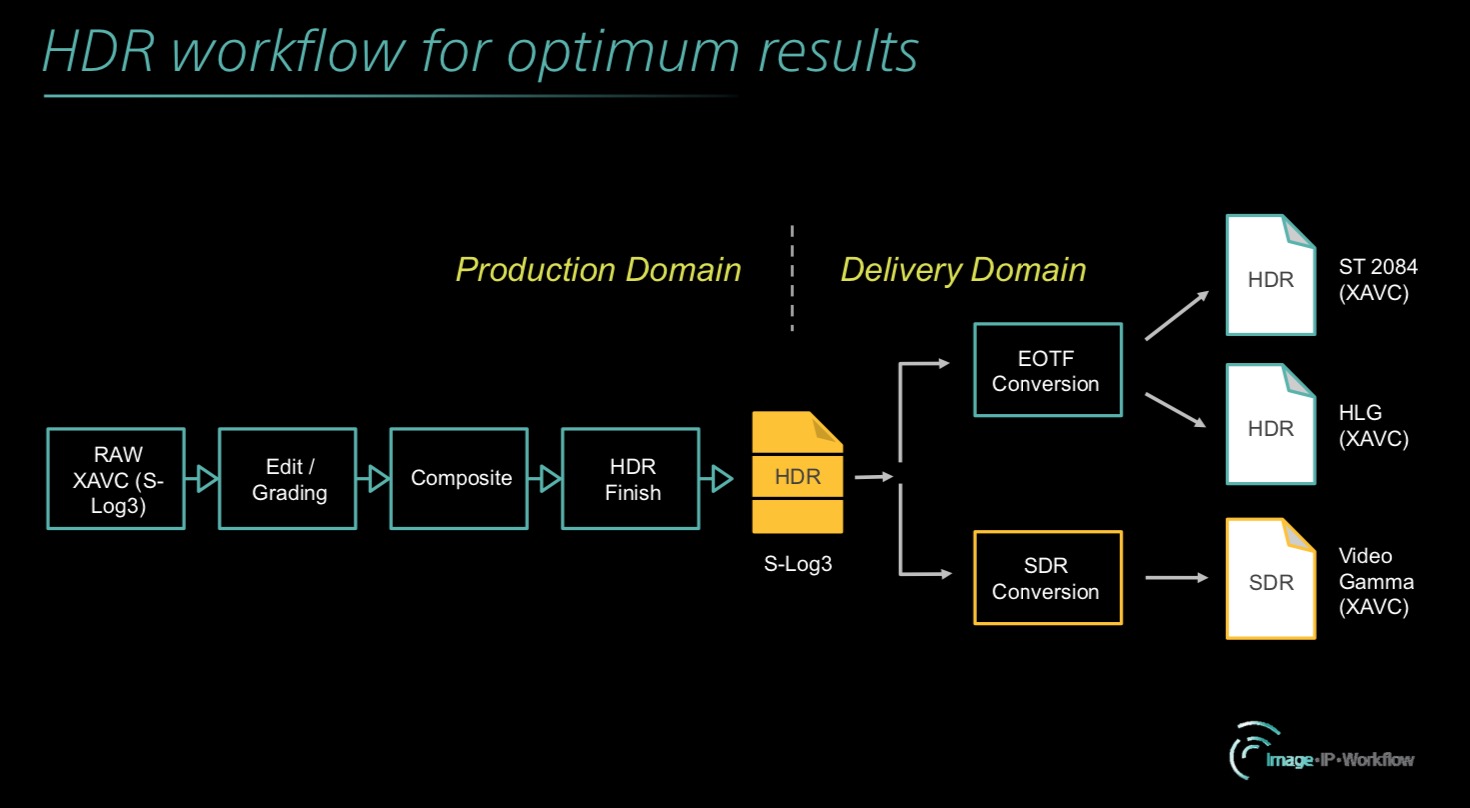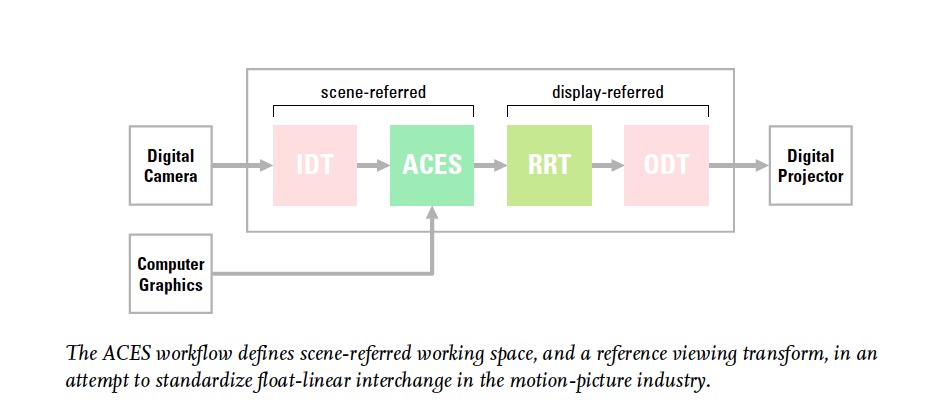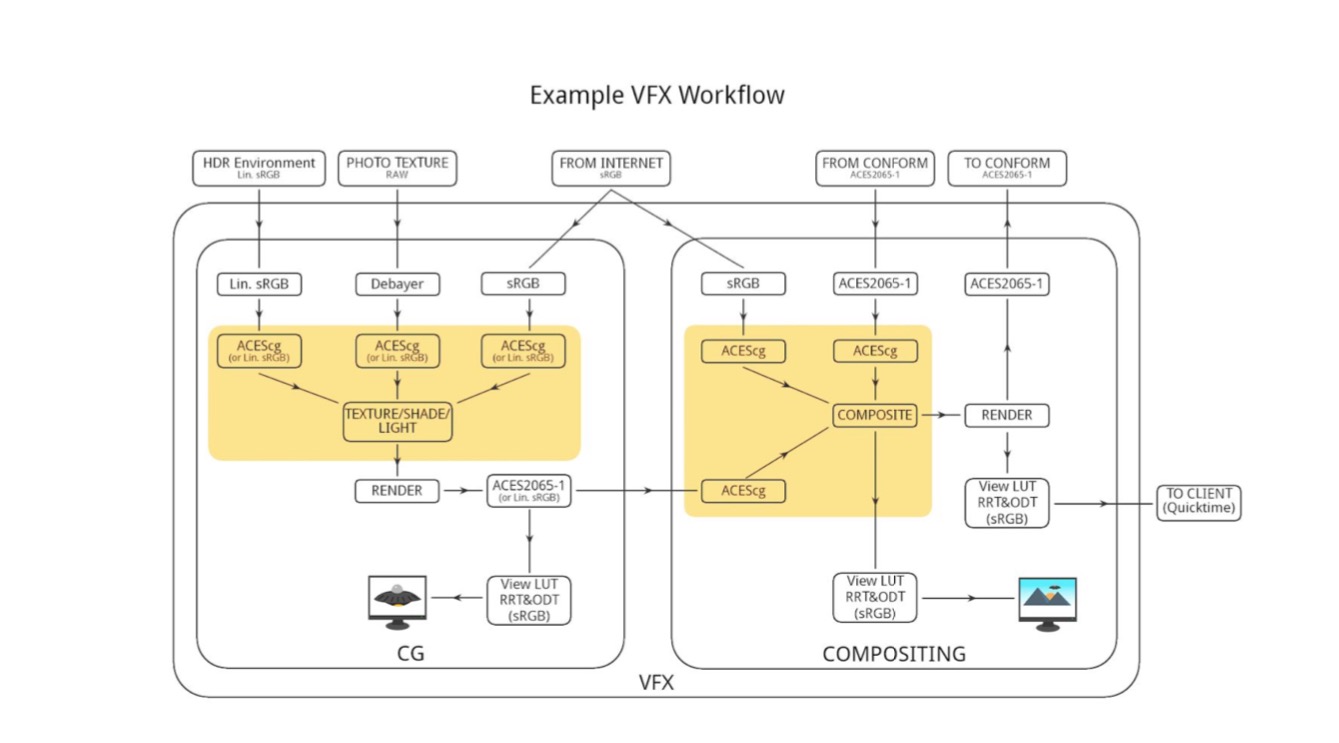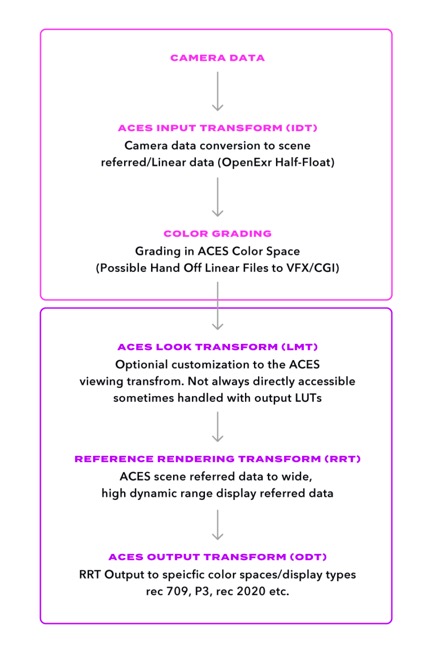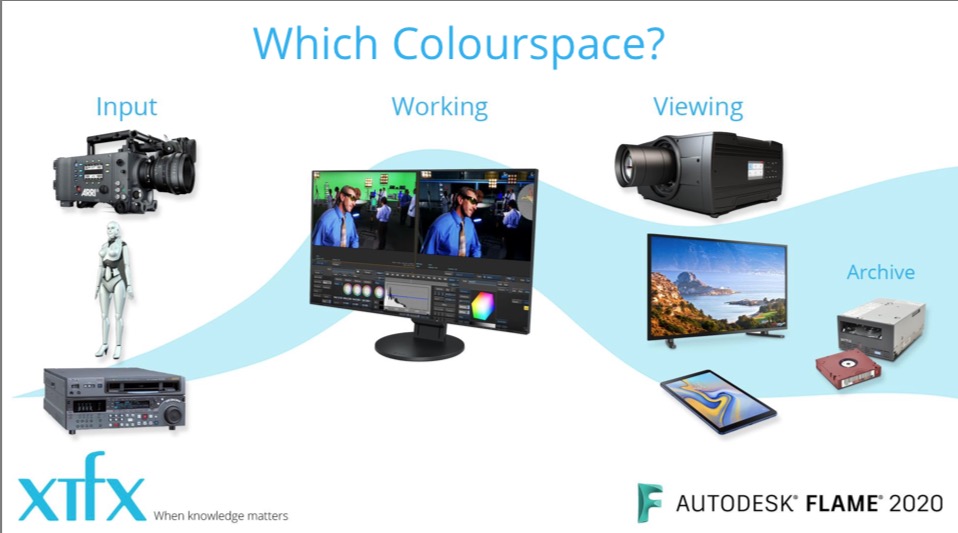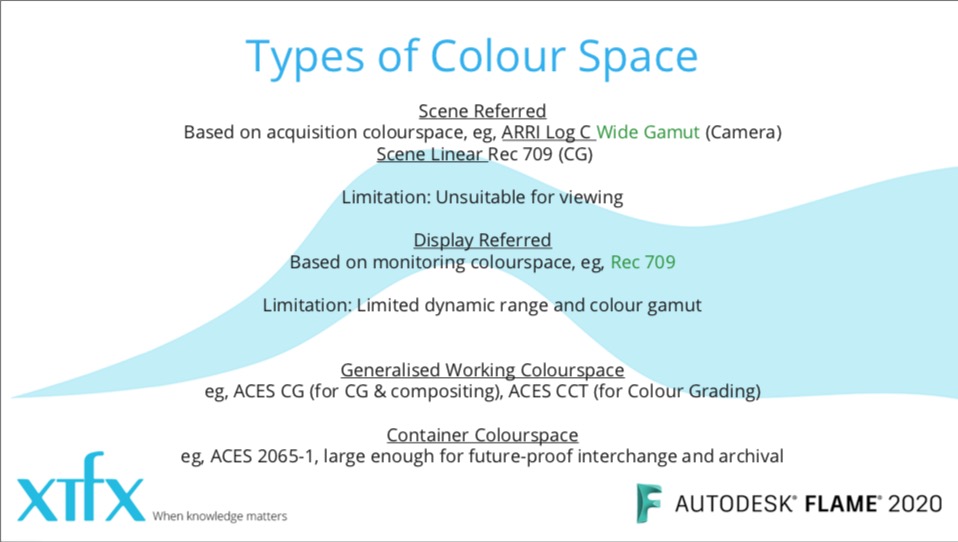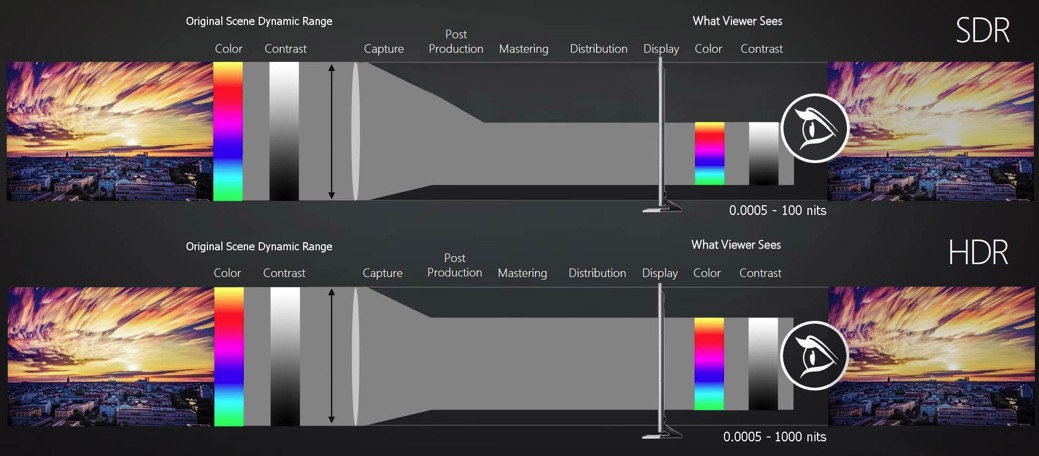Reflective Display Technology: Using Pigments and Structural Colors
Source: E-Ink Inc.

Key Terms
- E Ink
- E Paper
- ACeP (Advanced Colors e Paper)
- E Readers
- Note/Writing Pads
- E Labels
- E TAG
- E Newspaper
- E Whiteboard
- ESL (Electronic Shelf Label)
- Signage
- Displays
- Reflective Displays
- Flexible Displays
- LCD/LED Displays
- QLED
- OLED (Organic Light Emitting Diodes)
- AM-OLED
- Electrowetting Display (EWD)
- Glass Based e Paper
- Flexible e Paper
- CLEARInk (E Ink + LCD)
- CFA (Color Filter Array)
- Electrophoretic display (EPD)
- OTFT (Organic Thin Film Transistors)
- Flexible AM OLED
- Flexible AM EPD
- Active Matrix OLED (AM-OLED)
- Organic Electronics
- Flexible Electronics
- Printed Electronics
- Conjugated Conducting Polymers
- Transparent Displays
- Luminescent Displays
- Passive Matrix (PM)
- Reflective LCD
- Transmissive LCD
- Transflective LCD
- Cholesteric Liquid Crystals
- ElectroChromic Displays (ECD)
- ElectroFluidic Displays (EFD)
- Photonic Crystals Displays
- Plasmonic Colors Displays
Source: Active control of plasmonic colors: emerging display technologies
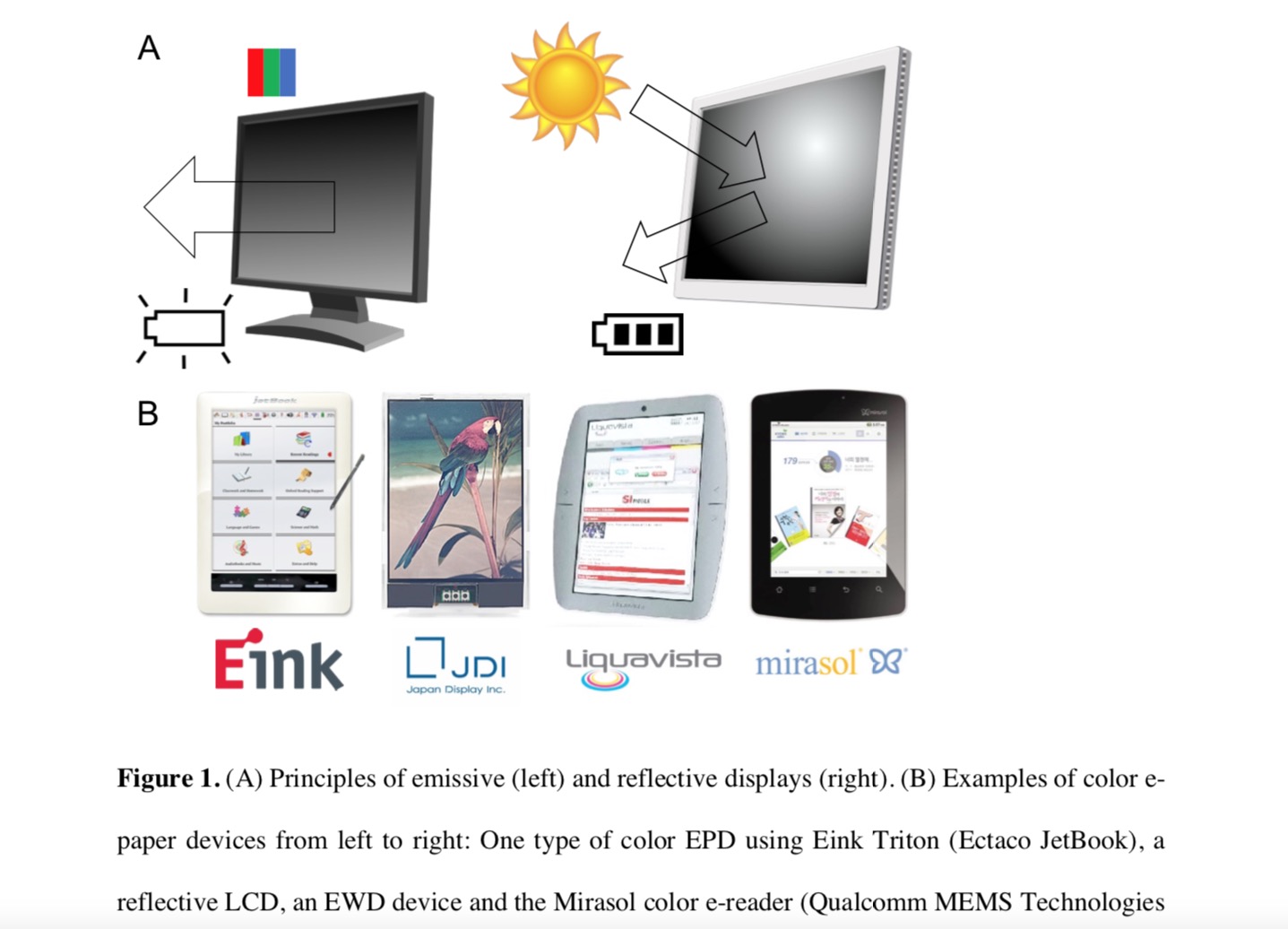
Source: Review of Paper-Like Display Technologies
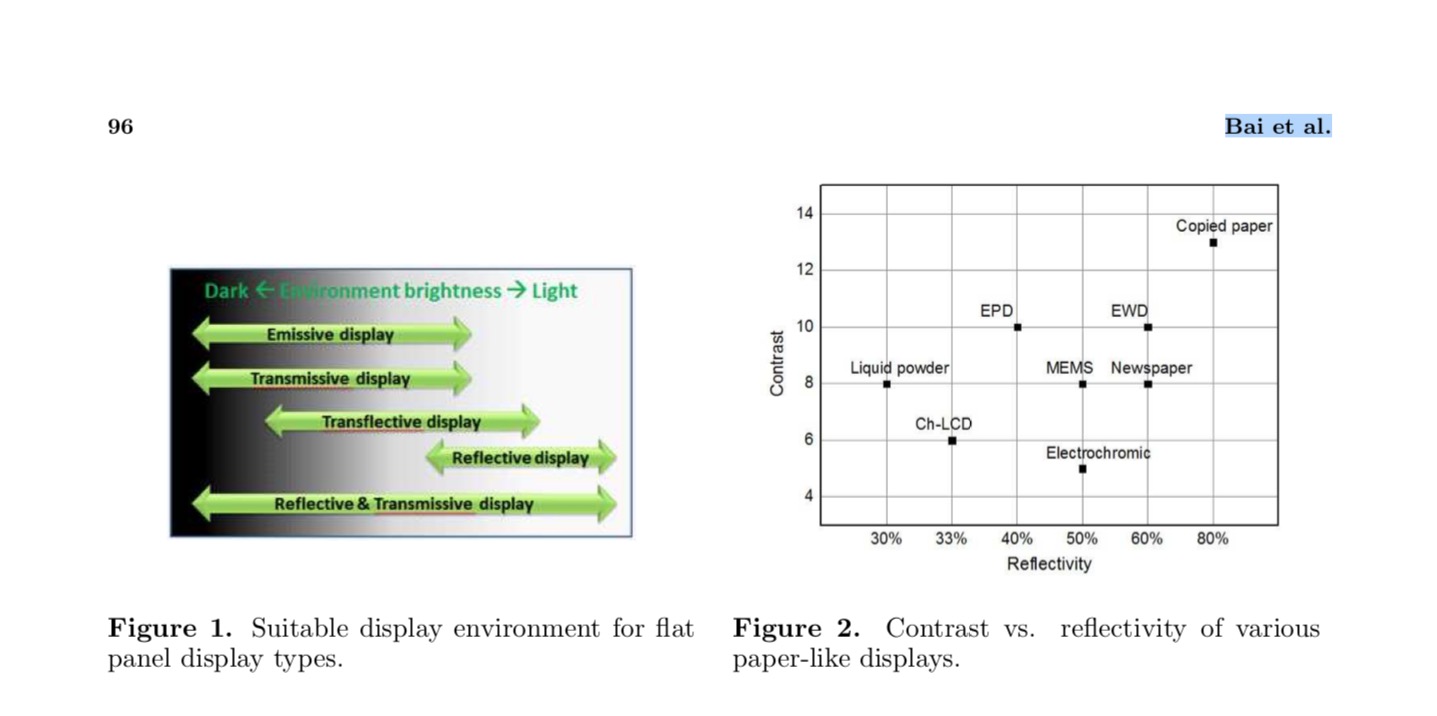
Technology of Dyes, Pigments, and Structural Colors
Source: Chromic Phenomena: Technological Applications of Colour Chemistry
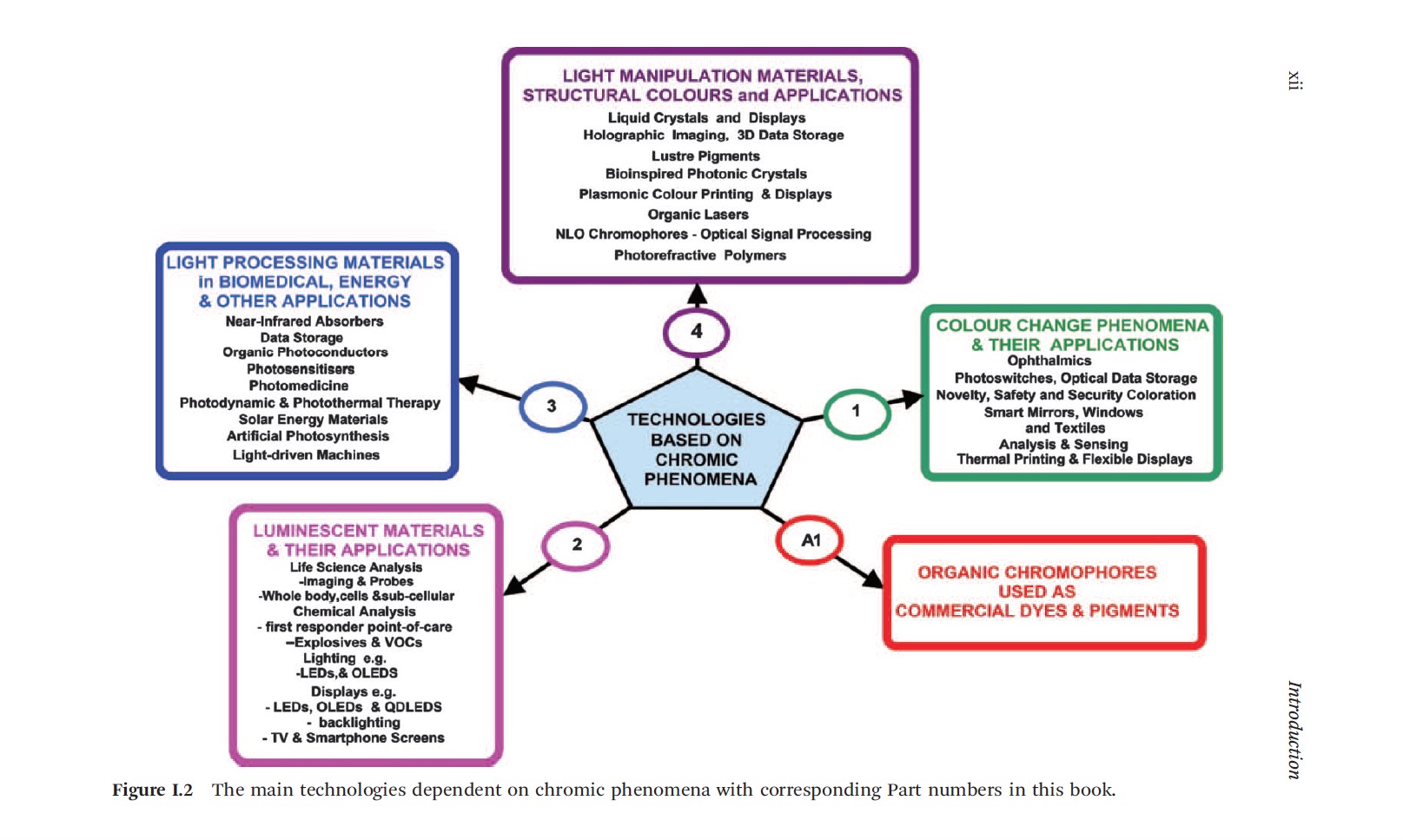
Reflective Color Generation Technology in Displays
- Pigmentation
- Structural
Source: DYNAMICALLY TUNABLE PLASMONIC STRUCTURAL COLOR

Review Paper: A critical review of the present and future prospects for electronic paper

Review Paper: A critical review of the present and future prospects for electronic paper

Types of Reflective e-Paper Technologies
(Color and Monochrome)
- Electrophoretic
- In-plane Electrophoretic
- Electrokinetic
- Liquid Powder
- Electrochromic
- Electrowetting
- Electrofluidic
- MEMS (electromechanical interference modulation)
- Cholesteric liquid-crystal displays (Kent Displays)
Source: Review of Display Technologies Focusing on Power Consumption
Electronic paper, popularly known as e-paper, can be defined as a dynamic display technology that emulates traditional paper. As LCD, e-paper belongs to the non-emissive display category but, in this case, no backlight is needed since the ambient light from the environment is enough.
The display is composed of millions of microcapsules containing positively charged white and negatively charged black particles suspended in a clear liquid, which are capable of producing the resolution only found in print. As they are bi-stable, they only consume power while the display is being updated. The power required for the update process depends on the size of the display.
The first commercial success of monochrome e-paper devices was due to the Electrophoretics technology, wrongly referred to as electronic paper displays (EPD), whose main exponent is microencapsulated electrophoretic displays, also known as e-ink [35]. Another similar approach, microcellular electrophoretic display films (SiPix), was bought by e-ink. There are other proprietary electrophoretic displays, which include Quick-Response Liquid Powder Display (QR-LPD) by Bridgestone [36], bichromal beads [37] by Xerox (Gyricon), or reverse emulsion electrophoretic display (REED) used by Zikon Corp.
Cholesteric liquid crystal (ChLCD), already mentioned as a subgroup of LCD, is generally classified as e-paper because of its zero consumption when it is not receiving screen updates.
Source: Review of Display Technologies Focusing on Power Consumption
A next generation of flexible, color and video e-paper is currently emerging. The most promising seems to be the electro-wetting approach (EWD) [38]. Its main component, liquavista (see Figure 3b), was developed by Philips but currently belongs to Amazon. Another interesting technology based on Interferometric Modulation (IMOD) is microelectromechanical sytems (MEMS) [39], whose potential has been demonstrated through several prototypes (trademarked Mirasol [40]) developed by Qualcomm.
Some other remarkable developments are the in-plane electrophoretics (IPE) patented by Canon [41] and HP’s Electrokinetic (EKD) [42], although they are at least several years away from a general market uptake [43].
Another less matured technology is electrofluidic [44], which presents the main novelty of using a three-dimensional microfluidic device structure and offering brilliantly colored aqueous pigment dispersions. Recently, other lines of investigation have aimed to simulate traditional paper through electronic paper made from microbial cellulose [45].
Source: Biological versus electronic adaptive coloration: how can one inform the other?

Other reflective liquid-crystal displays
- Conventional reflective polarizer-based liquid crystal
- Transflective liquid-crystal displays
- Electromagnetic (EMD ) displays
- Photonic Crystals Displays (P -Ink)
- Plasmonic Structural Colors
Other Display Technologies
- Bistable LCDs – Reflective – Cholesteric
- Nemoptic – BiNem/OLED dual Mode Display- Sold rights to Seiko Japan
- ZBD Display – PM-LCD Reflective Display – Acquired by New Vision Display China
- Fujitsu’s Color E-paper Mobile Display – FLEPia – Discontinued 2010
Reflective Displays using Pigments
- Electrophoretic Displays
- Electrowetting Displays
- Electrochromic Displays
Electrophoretic Displays – Reflective
(eReaders and Note taking/Writing Pads)
(Monochrome and Color)
(EPD)
- E ink
- E Paper
- Yotaphone
- E Ink Triton
- E Ink Triton 2
- E Ink Kaleido
- E Ink Kaleido 2
- Hisense
- Pocketbook
- Onyx Boox Poke 2
- Onyx Max Lumi
- Quirk logic Papyr
- Ratta Supernote A5X
- Onyx Note Air
- iReader
- iFLYTEK
- Amazon Kindle
- Etch a Sketch
- Magna Doodle
- Remarkable 2
- Ricoh Whiteboard 42 inch
- Hisense A7 CC 6.7 Inch Smartphone
- Kobo Libra H20
- Amazon Paperwhite
- Amazon Oasis
- Bigme S3 7.8 Color E-reader
- Kobo Nia e Readers
- Boyue Likebook
- Pocketbook Inkpad Color
- Onyx Boox Poke 2 Color
Electrophoretic Displays – Reflective
Source: Stretchable and reflective displays: materials, technologies and strategies

Electrophoretic Display
Source: Review Paper: A critical review of the present and future prospects for electronic paper

In-plane Electrophoretic Display
Source: Review Paper: A critical review of the present and future prospects for electronic paper
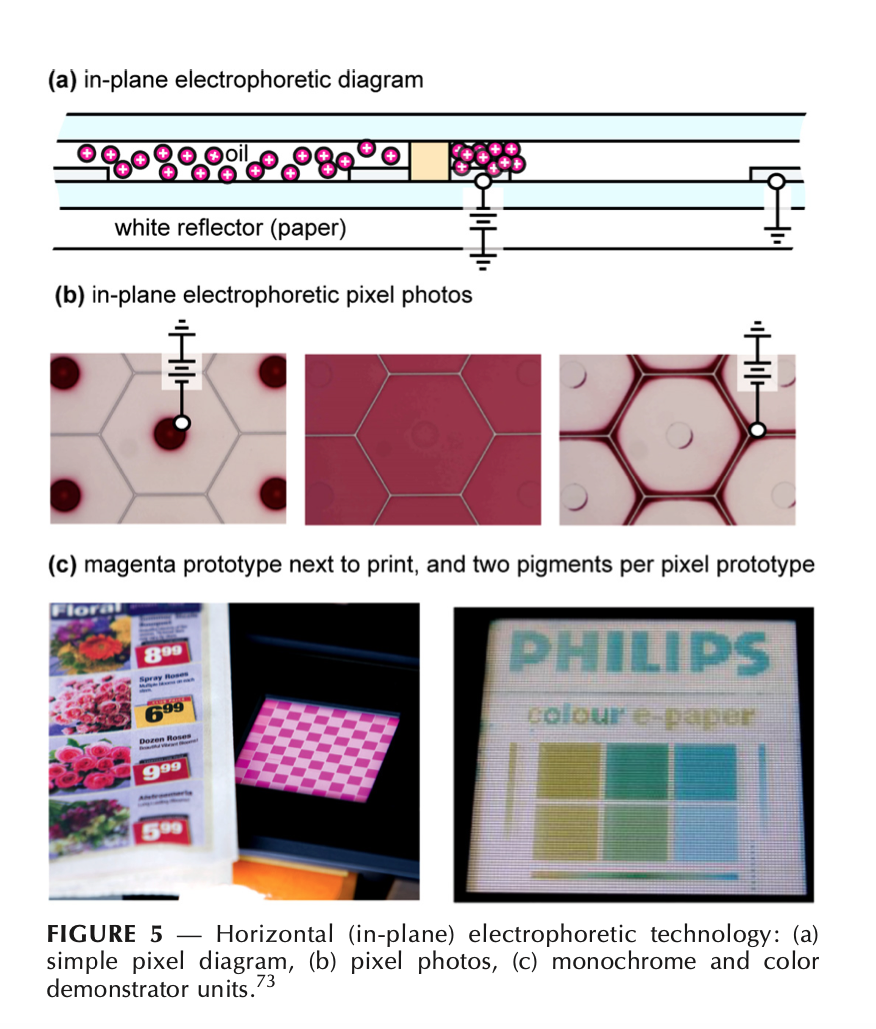
ElectroKinetic Displays
Source: Review Paper: A critical review of the present and future prospects for electronic paper

Liquid Powder Display
Source: Review Paper: A critical review of the present and future prospects for electronic paper

Companies manufacturing Reflective Displays
The key players in the global e-paper display market are
- Displaydata Ltd. (UK)
- Display Innovations (UK)
- Kent Displays, Inc. (USA)
- LANCOM Systems GmbH (Germany)
- Liquavista B.V. (The Netherlands)
- Xerox Corp. (USA)
- Zikon, Inc. (USA)
- Qualcomm
- Gamma Dynamics
- ITRI
- GUANGZHOU OED TECHNOLOGIES CO., LTD
- InkCase Enterprise Pte Ltd
- Plastic Logic HK Ltd
- GDS Holding S.r.l.
- Epson Europe Electronics GmbH
- GDS S.p.a
- Motion Display
- MPicoSys Low Power Innovators
- Omni-ID
- Solomon Systech
- E Ink Holdings Inc (Taiwan)
- Sony Corporation (Japan)
- Pervasive Display Inc (Taiwan)
- Samsung Display Co, Ltd (South Korea)
- LG Display Co Ltd. (South Korea)
- Plastic Logic GmbH (Germany)
- Cambrios Technologies Corporation (US)
- Bridgestone Corporation (Japan)
- Visionect (Slovenia)
- CLEARink Displays (US)
Global E-Paper Display Market Scope and Market Size
E-paper display market is segmented on the basis of product, type, technology and end user. The growth among segments helps you analyse niche pockets of growth and strategies to approach the market and determine your core application areas and the difference in your target markets.
• E-paper display market on the basis of product has been segmented as e-readers, mobile devices, smart cards, poster & signage, auxiliary displays and electronic shelf label, and wearables.
• Based on technology, e-paper display market has been segmented into electrophoretic display, electrowetting display, cholesteric display, interferometric modular display, and others.
• On the basis of type, e-paper display market has been segmented into flat EPDs, curved EPDs, flexible EPDs, and foldable EPDs
• E-paper display has also been segmented on the basis of end user into automotive, consumer electronics, retail, healthcare and media & entertainment.
E-PAPER DISPLAYS EXPLAINED
We so often eulogise about the limitless possibilities e-paper displays enable and the exciting opportunities the technology creates for market growth, differentiation and competitive advantage — but for the uninitiated reader, we thought it might be helpful in this blog to take a step back and look at how e-paper works.E-paper goes by many names and spellings — electronic paper, ePaper, electronic ink, e ink, electrophoretic displays, EPD — but all these terms effectively describe the same thing: an electrically-charged surface that replicates the look and experience of ink on paper.
Instead of a traditional display that uses backlighting to illuminate pixels, e-paper is based on the science of “electrophoresis” — i.e. the movement of electrically charged molecules in an electric field.
In every e-paper display there are millions of tiny microcapsules containing (negatively charged) black and (positively charged) white pigments suspended in a clear fluid. This encapsulated ‘ink’ is then printed onto a plastic film and laminated on to a layer of circuitry, or — to be even more specific — a transistor matrix layer. The circuitry forms a pattern of pixels that is then controlled by a display driver (EPD controller).
When a negative electric field is applied to the ‘ink’, the white particles move to the top of the capsule making the surface appear white at that specific spot. Reverse this process and the black particles appear at the top making the surface of the capsule appear dark. The technology can also work in colour in just the same way but using a combination of different colour pigments and electric charges, or just by adding a colour filter on top of the display.
The way e-paper works differs from traditional displays in two key ways:
E-paper screens are reflective — light from the environment is reflected from the surface of the e-paper display towards the user’s eyes, just like with traditional paper. This gives e-paper a wide viewing angle that is readable in direct sunlight.
E-paper screens are bi-stable — unlike conventional backlit flat panel LCD displays, which refresh about 30 times per second and require a constant power supply to maintain content, e-paper displays will hold a static image ‘forever’, even without electricity. E-paper only consumes power when the content on it changes – for example if an e-paper shelf label in a supermarket is updated with a new price. The rest of the time the display will simply show the content you want it to, where it doesn’t draw any power until the next update.Making e-paper flexible
Here at Plastic Logic Germany, we took e-paper one stage further and successfully industrialised a process to create glass-free backplanes, which represents the transistor matrix layer mentioned above. We are the first company worldwide able to manufacture transistor arrays on plastic. Instead of using traditional silicon transistors, our active-matrix backplane consists of organic thin film transistors (OTFTs) made from the same plastic used to for cola bottles (PET). This means we can couple a flexible backplane with a flexible display medium, such as flexible OLED or flexible electrophoretic layer, to create a fully flexible display with limitless possibilities. In addition to the flexibility, our glass-free electrophoretic displays also more robust, shatterproof and lightweight compared to glass-based displays.
If you want to know more about flexible plastic e-paper display technology’s suitability for a given use case and to get some inspiration via the applications which are already successfully showcasing the opportunities and rewards achievable through flexible e-paper innovation check out our latest flexible e-paper whitepaper.
By Plastic Logic
Flexible Displays
- Flat
- Curved
- Foldable
- Rollable
- Printable
- Without Glass
- On Plastic
Electrowetting Displays (EWD)
- LiquaVista
- Etulipa
- ADT
CMY Colors vs RGB Colors

Source: Current commercialization status of electrowetting-on-dielectric (EWOD) digital microfluidics
The emergence of electrowetting-on-dielectric (EWOD) in the early 2000s made the once-obscure electrowetting phenomenon practical and led to numerous activities over the last two decades. As an eloquent microscale liquid handling technology that gave birth to digital microfluidics, EWOD has served as the basis for many commercial products over two major application areas: optical, such as liquid lenses and reflective displays, and biomedical, such as DNA library preparation and molecular diagnostics. A number of research or start-up companies (e.g., Phillips Research, Varioptic, Liquavista, and Advanced Liquid Logic) led the early commercialization efforts and eventually attracted major companies from various industry sectors (e.g., Corning, Amazon, and Illumina). Although not all of the pioneering products became an instant success, the persistent growth of liquid lenses and the recent FDA approvals of biomedical analyzers proved that EWOD is a powerful tool that deserves a wider recognition and more aggressive exploration. This review presents the history around major EWOD products that hit the market to show their winding paths to commercialization and summarizes the current state of product development to peek into the future. In providing the readers with a big picture of commercializing EWOD and digital microfluidics technology, our goal is to inspire further research exploration and new entrepreneurial adventures.
Source: Stretchable and reflective displays: materials, technologies and strategies
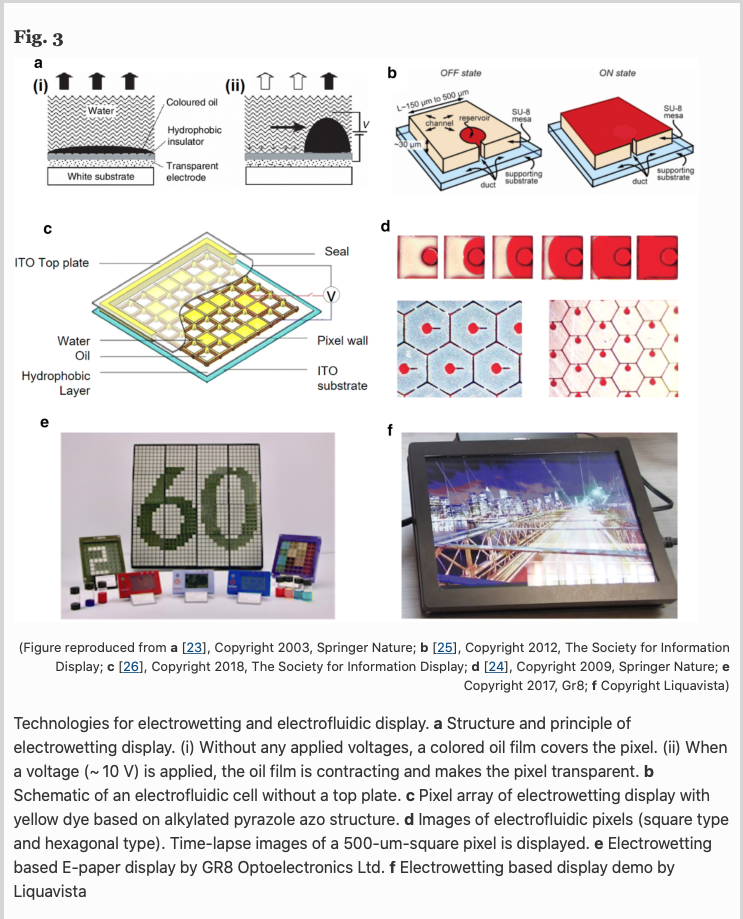
Liquavista technology was acquired by Samsung and then later was sold to Amazon. Amazon has put it on shelves.
Source: Biological versus electronic adaptive coloration: how can one inform the other?

Electrowetting Display
Source: Review Paper: A critical review of the present and future prospects for electronic paper
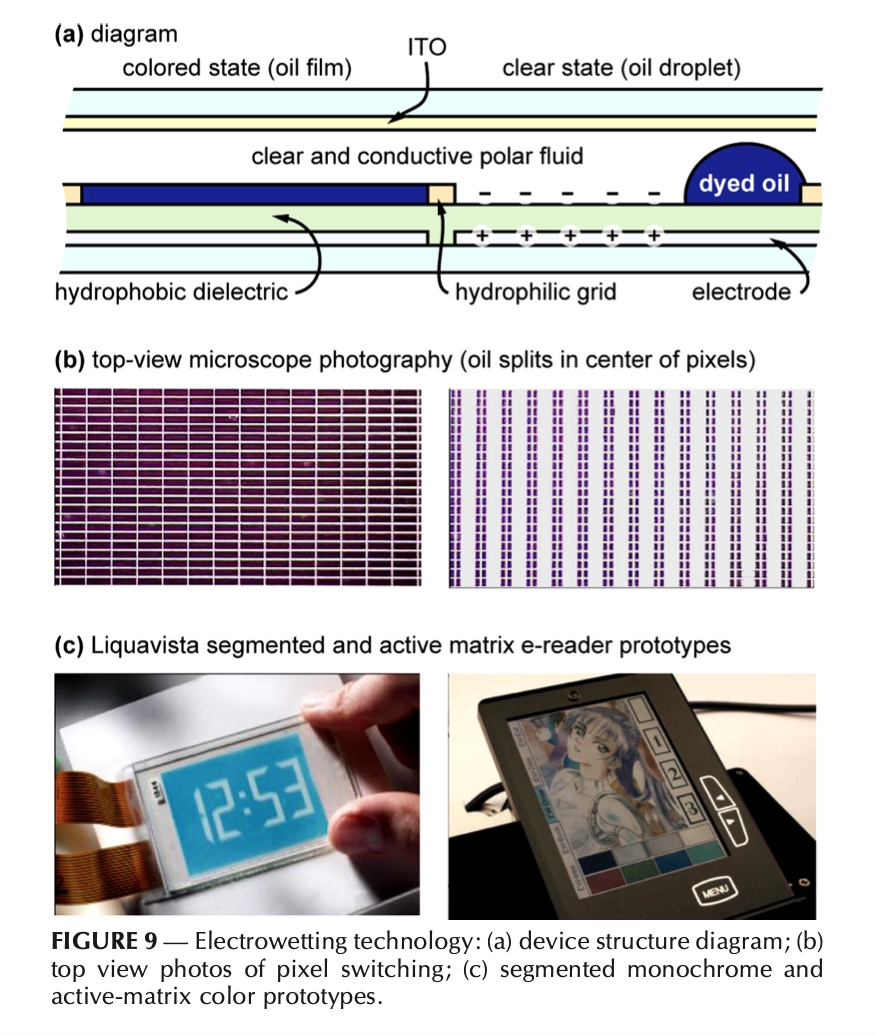
ElectroFluidic Display
Source: Review Paper: A critical review of the present and future prospects for electronic paper

Electrochromic Displays
- rdot / Ynvisible Interactive
- https://www.ynvisible.com/products
- mECD by RICOH
- Transprint method
Source: IllumiPaper: Illuminated Interactive Paper
In general, display technologies can be classified in pixel-addressable high-resolution displays (e.g. OLED, e-paper) and in segment displays, which highlight predefined shapes based on electrochromism (EC) [2], thermochromism (TE) [31] or electroluminescence (EL) [1, 46]. Although advanced display types, such as e-paper, have promising properties (e.g., preserving content without battery), we focus on lightweight, low-current-consuming, segment-based EL and EC displays, which are robust, inexpensive and easy to integrate with pen interaction.
RDOT Tech
Source: Stretchable and reflective displays: materials, technologies and strategies

Electrochromic Displays
Source: Review Paper: A critical review of the present and future prospects for electronic paper
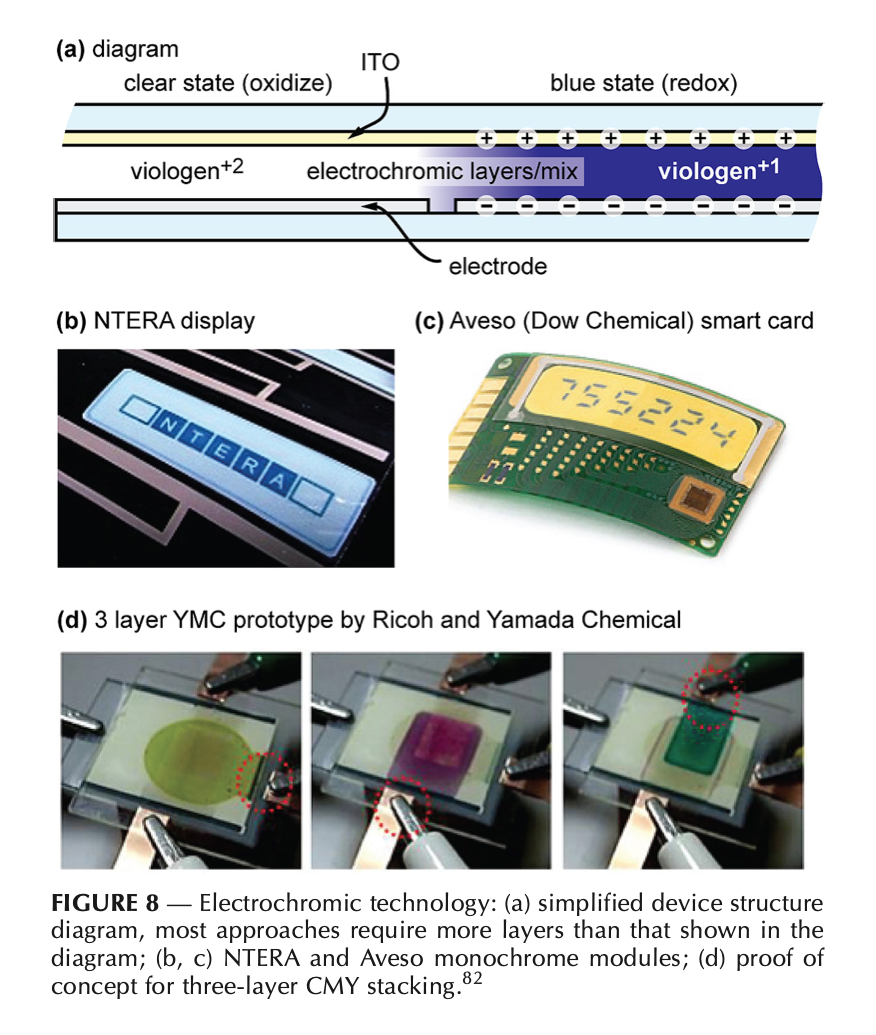
This technology was formerly by Swedish company Rdot, which was co-founded by Karlsson, and bought by Ynvisible Interactive of Vancouver. The company has prototyping capabilities in Linköping, Sweden and in Almada, Portugal, roll-to-roll production in Sweden, and R&D in Freiburg, Germany.
Printed Electrochromics boldly goes where no display has gone before
This is a sponsored post by Ynvisible
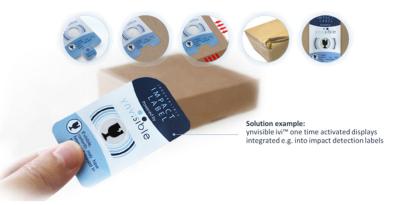
Fig.1 Example use case for printed electrochromics: a shock detector smart label with an interactive printed interface.
Expanding Need for Simple Electronic Display Functionality
Rapid advances in the miniaturization and reduction of costs in computing, electronic sensing, and communications have allowed the integration of “smart” electronic functionality into almost everything. ”Intelligence” is now embedded into a wide range of everyday objects, and spread throughout our working and living environments. Much of this intelligence, data collection and transfer is hidden from the human senses, requiring little or no human involvement. But as the number of human daily touch points and interactions with smart devices grows, so too does the importance of user experience design and the role of displays.
Conventional electronic displays cannot be economically and sustainably applied into all smart objects and environments and can often times be functionality overkill for the simple display requirements of many everyday objects. Also, user experiences built around the need for extensive use of separate reading devices, e.g. RFID or Bluetooth readers in smart phones, can be increasingly challenging especially with the high number of distractions and strong competition for attention on mobile screens. Further with a doubling of screen time over the past four years among certain user demographics, there is also a growing sense of screen fatigue leading to people “detoxing” from light emitting screens while still valuing user interfaces that are useful yet unobtrusive.
“As technology becomes ubiquitous, it also becomes invisible.“
– Kevin Kelly, Wired magazine Founding Executive Editor
When technology becomes ubiquitous, it needs to seamlessly blend into the product and our surroundings. The user experience should be effortless. As the “computing” or intelligence blends into smart objects and environments, also the displays need to become more practical: i) eliminating the need for recharging or replacing of batteries, ii) eliminating the amount of effort to access information, and iii) be inexpensive for intended purpose.
Printed Electrochromics Brings Everyday Printable Objects and Surfaces to Life
Electrochromic devices (ECD) are electrochemical cells where color changes occur upon electrochemical reactions of two or more redox active electrochromic materials electrically connected by an external circuit and physically separated by an ionic conducting layer (electrolyte layer). Electrochromic materials and devices can be controlled to change their color and opacity by the application of electrical stimuli. ECDs are a non-light emitting reflective technology. Materials for ECD manufacture can be taken into the form of printable inks and the manufacturing processes made compatible with standard graphic printing and converting processes. The resulting device can be made thin, flexible, transparent, robust, and ultra low-power. As ECDs can be produced into a wide range of different shapes and sizes, they offer a wide range of advantages for product design and integration.

Fig.2 Electrochromic devices can be printed in sheet-to-sheet or roll-to-roll.
Ynvisible Production R2R line in Linköping, Sweden.
R&D toward printed electrochromics began in the 1990s. In recent years, with strong advances in printed electronic and hybrid electronic systems, developments of ECDs have made strong technical progress into mass-manufacturability. Electrochromic displays and visual indicators are now entering markets that are considered “blue ocean” from the perspective of the electronic display industry. In these market spaces conventional printed products and surfaces now meet electronics. The over 800 billion USD per year printing industry, and particularly the industrial printing sub-sector, are welcoming printed electronic systems with high level of interest.
Things Alive
Today Ynvisible Interactive Inc. (“Ynvisible”) is leading the charge to bring printed electrochromics into market. Ynvisible was established with the vision to bring everyday objects and surfaces to life benefitting people in a smart and connected world. The company’s mission is to provide practical human interfaces to smart everyday objects and ambient intelligence.
After early explorations into different chromogenic systems the company focused on developing electrochromics into a mass producible, ultra-low power consuming visual interface technology. The company now develops and commercializes different printed electrochromic systems on film materials. By combining other printed electronic components and microelectronics into the electrochromic system, the company designs and produces interactive graphic solutions for everyday smart objects and surfaces.
Ynvisible aims to be the leading supplier of design tools, inks and quality control systems for the design and production of interactive printed graphics based on printed electrochromics and other printed electronics technologies. The company is building its technology and products platform under the ynvisible™ brand (ynvisible is a registered trademark in certain countries and territories).
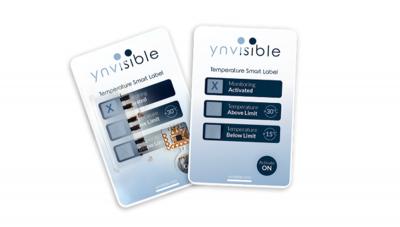
Fig. 3 Electrochromic displays on a temperature label provide clear visual indication and are
easy to implement – user friendly and available in high volumes.
Ynvisible’s primary focus is on applications in retail and logistics (where ECDs are printed onto RFID tags and RF-based smart labels), premium consumer brand products, and healthcare and wellness (in particular medical and diagnostic devices). Today the company offers a full services package to help product developers and designers get started with printed electrochromics. Ynvisible’s design, prototyping, customer training and sheet-to-sheet production services are based in Almada, Portugal. The company’s inks development and R&D services are based in Freiburg, Germany. In Linköping, Sweden the company operates a roll-to-roll production facility with extensive printing, converting, and quality control system capabilities. In addition to high volume ECD printing, the high capacity production line is utilized for printing of other printed electronic components and systems. Ynvisible sells printed electronics production upscaling services to other product owning companies.
Ynvisible Interactive Inc. is a publicly traded company, listed in the Toronto Stock Exchange Venture list [TSXV:YNV], the OTC Markets [OTCQB:YNVYF] and the Frankfurt Stock Exchange [FRA:1XNA]
Getting Started With Printed Electrochromics
To learn more about Printed Electrochromics, Ynvisible is hosting a free webinar on Apr 2, 2020 12:00-1:00 PM in Eastern Time (US and Canada). The one hour webinar includes speakers from the Georgia Institute of Technology, NXN-IP and the University of Lapland. To register see: https://www.ynvisible.com/events

Fig.4 Printed paper label with printed NFC antenna and printed electrochromic display on the same substrate.
A collaboration between Arjowiggins and Ynvisible.
Worldwide Industry for Electrochromic Materials to 2025 – Impact of COVID-19
Electrochromic Materials Market Landscape
Technology launches, acquisitions, and R&D activities are key strategies adopted by players in the electrochromic materials market. In 2019, the market of electrochromic materials has been consolidated by the top ten players accounting for 65.4% of the share. Major players in the electrochromic materials market are Gentex corporation, Saint Gobain, View, Inc., ChromoGenics, AGC, Inc., Changzhou Yapu New Materials Co. Ltd., Magna Glass and Window Company Inc., Econtrol-Glass Gmbh & Co. KG, Nikon Corporation, and Zhuhai Kaivo Optoelectronic Technology Co. Ltd. among others.
- Electrochromic Materials
- Metal Oxides
- Viologens
- Conducting Polymers
- Prussian Blue
- Others
- Electrochromic Materials Market
- Automotive Rear View Mirrors
- Smart Glass Windows
- Displays
- Others
https://www.alliedmarketresearch.com/electrochromic-glass-market
ElectroChromic Glass Markets
Region wise, the market is segmented into North America, Europe, Asia-Pacific, and LAMEA. Europe was the highest revenue contributor in 2019. The presence of leading automotive manufacturers using electrochromic glass is expected to drive the growth of the market. Electrochromic glasses yield better energy savings and comfort and are increasingly used in panoramic roofing in cars. It is already being used in Mercedes-Benz SLK and SL roadsters. Similarly, in 2019, AGP Group, one of the world’s leading glazing manufacturers, opened its automotive glazing plant in Belgium for producing panoramic roofs with electrochromic glass. This trend indicates a growing market for electrochromic glasses in automotive applications.
Smartphone manufacturers are developing phones containing electrochromic glasses to increase their share in the global electrochromic glass market share. For instance, at CES 2020, Chinese phone maker, OnePlus announced Concept One phone that uses electrochromic glasses to hide its rear triple cameras, when not in use. This phone is not expected to be mass produced but it opens a new end-use for electrochromic glass in the smartphone market, which is largely dominated by countries such as China, India, and Japan. Further, China is one of the world’s largest smartphone makers.
The major electrochromic glass manufacturers analyzed in this report include AGC Inc., ChromoGenics AB, Compagnie de Saint-Gobain S.A., Hitachi Chemical Co. Ltd., Kinestral Technologies Inc., Pleotint LLC, Polytronix Inc., Research Frontiers Inc., Smartglass International Ltd., and View Inc. To stay competitive, these market players are adopting different strategies such as product launch, partnership, merger, and acquisition. For instance, on December 2017, AGC, Kinestral Technologies Inc. and G-Tech Optoelectronics Corp. announced a joint venture that will sell, distribute, and service Halio smart glasses to the global market. The new ventures are Halio North America, Halio International, and Halio China. The joint venture helped AGC to increase its market revenue.
Multilayered ECD by Ricoh using CMY Colors
Source: Multi-Layered Electrochromic Display

Reflective Displays based on Conventional LCD
- Reflective LCD
- Japan Display Inc – MIP Reflective LCD
- Samsung – SR (Super Reflectance) LCD Technology
Types of Reflective LCDs
- Direct View
- Projection
Japan Display Inc.
Japan Display Inc (JDI) is an LCD technology joint venture by Sony, Toshiba, and Hitachi since 2012.
Memory-in-pixel (MIP) Reflective Color LCD
Japan Display Inc. (JDI), a leading global supplier of small- and medium-sized displays, has announced the start of sales of a standard line-up of memory-in-pixel (MIP) reflective-type color LCD modules for wristwatch-type wearable devices which realize ultra-low power consumption. Power consumption of these reflective-type LCD modules is less than 0.5%*1 that of transparent-type LCD modules.
Source: Japan Display Inc.

Source: JAPAN DISPLAY SHOWS LOW-POWER REFLECTIVE LCD THAT DOES COLOR, VIDEO

Emerging Display Technologies
- MIP Reflective Color LCD for Ultra Low Power Consumption
- Organic Electro-Luminescent (EL) display for High Contrast and Thin Structure
- Transparent Display
- Light field display (LFD) for 3D Definition (Holographic)
- Micro LED display
- Hybrid OLED and Reflective LCD
Transflective LCD Displays
Transflective LCDs combine elements of both transmissive and reflective characteristics. Ambient light passes through the LCD and hits the semi-reflective layer. Most of the light is then reflected back through the LCD. However some of the light will not be reflected and will be lost. Alternately a backlight can be used to provide the light needed to illuminate the LCD if ambient light is low. Light from the backlight passes through a semi-reflective layer and illuminates the LCD. However as with ambient lighting some of the light does not penetrate the semi-reflective layer and is lost.
Depends both on Transmission and Reflection.
Types of Transflective LCDs
Source: Fundamentals of Liquid Crystal Devices
Based on the light modulation mechanisms, transflective LCDs can be classified into four categories:
- absorption type
- scattering type
- reflection type
- phase retardation type
https://pid.samsungdisplay.com/en/learning-center/blog/reflective-display-technology
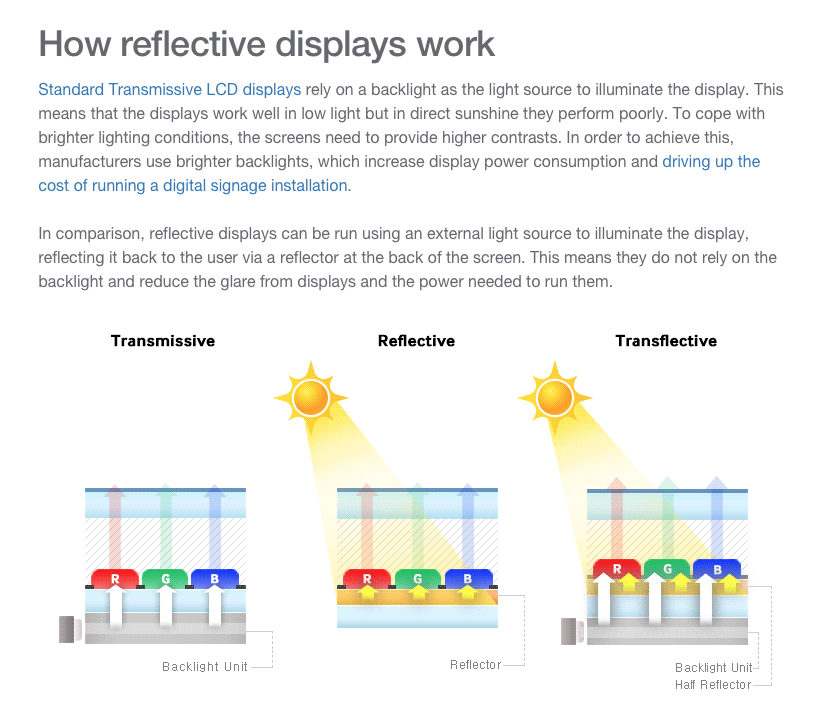
https://pid.samsungdisplay.com/en/learning-center/blog/reflective-display-technology

Color-reflective LCD based on cholesteric liquid crystals
- Kent Displays Inc.
- Cholesteric liquid crystal (CLC)
- Kent State University/Deng-Ke Yang
Cholesteric liquid crystals (hereafter Ch LCs) are self-assembled systems consisting of elongated chiral organic molecules. They possess a helical structure where the local average direction of the molecules twists spatially around an orthogonal helical axis. Their refractive index varies periodically, and thus exhibits a Bragg reflection band centered at the wavelength λ = [(ne + no)/2]P and with the bandwidth Δλ = (ne – no)P, where ne and no are the extraordinary and ordinary refractive indices of the LC, respectively, and P is the helical pitch. They can be used to make reflective displays which do not need polarizers and have high reflectance.
Dr. J. William Doane is a world renowned expert in the field of liquid crystal materials and devices. Together with William Manning he co-founded Kent Displays, Inc. in 1993 and the company is now famous for its Cholesteric LCD based Boogie Board writing tablets that use Dr Doane’s inventions. Dr. Doane, was the director of the world-renowned Liquid Crystal Institute at Kent State University from 1983-1996 and led the effort during that time to establish the National Science Foundation Center for Advanced Liquid Crystalline Optical Materials (ALCOM). As an active member of the international science community, he has held visiting appointments and maintained cooperative research programs in several countries. Dr. Doane was instrumental in formalizing the International Liquid Crystal Society and served as the organization’s first treasurer from 1990-1996. Dr. Doane was named a Fellow of the American Physical Society in 1982 and retired from the Kent State University in 1996 after a 31-year teaching and administrative career. Dr. Doane received the first ever presentation of the Slottow-Owaki Prize for Display Education, by SID.
Source: Bistable Liquid Crystal Displays

Cholesteric LCD Display
Source: Review Paper: A critical review of the present and future prospects for electronic paper

Reflective Displays Using Structural Colors
- Interferometric Modulator Display (IMOD)
- Photonic crystal displays (P-Ink)
- Plasmonic Structural Colors Displays
Source: : E SKIN Displays
A wide range of reflective displays have recently been developed, and Fig. XX compares several of the most prominent. Much like color generation in animals, reflective displays can be separated into the same two main categories; pigmentation and structural color. Under the tent of pigmentation are products such as e-ink based “E-readers”, and color filter based liquid crystal displays. E-readers use the translocation of 3 charged pigmented beads, and as such, require seconds to switch between images. Due to the macroscopic size of each pixel, resolution and color reproduction are also limited. Reflective liquid crystal displays are much quicker, taking only milliseconds to switch states, but are limited in brightness as polarizers immediately halve the amplitude of the reflected light. Many structural color based displays are currently in development and have only recently entered the market. One such device is an interferometric modulator produced by Qualcomm where within each pixel, a cavity is formed between a Bragg stack and a MEMs mirror. By controlling the cavity spacing, the reflected light experiences either constructive or destructive interference resulting in a bright color or dark state. While producing the signature bright vivid colors of Bragg reflection, the device is inherently angle sensitive and limited to rigid substrates. Another emerging structural color based device uses a photonic crystal made from silica spheres submerged within an electro-active polymer, and is branded Photonic Ink (P-ink). The polymer stretches as a field is applied, increasing the period of the photonic crystal and therefore the wavelength of reflected light. Though the colors are vivid and tunable, the response time of the polymer is tens of seconds, making video impossible. Cholesteric and blue phase LC displays behave in a similar manner. Helixes of LC form periodic nanostructures which produce Bragg reflections at desired wavelengths. The LC structures can be switched through an external field thereby producing dark and light states. While producing vivid color, these devices are limited in brightness as the helical structures only reflect circular light of the same handedness of the LC. By assessing current technologies we determine there is much to understand and develop in order to truly mimic color generation in nature. A fast response, angle independent LC-metasurface based display which can actively shift the color of its pixels from RGB to black holds the promise for development of truly thin-film flexible displays.
Interferometric Modulator Display (IMOD)
(Structural Interference Colors)
- Qualcomm Mirasol
- MEMS Micro-Electro-Mechanical-Systems
MEMS Display
Source: Review Paper: A critical review of the present and future prospects for electronic paper
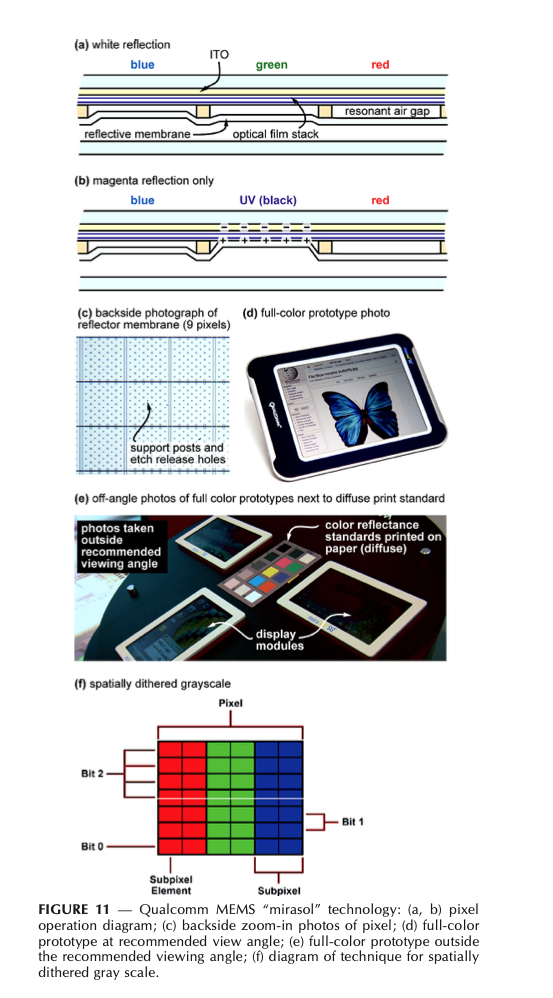
Source: Biological versus electronic adaptive coloration: how can one inform the other?
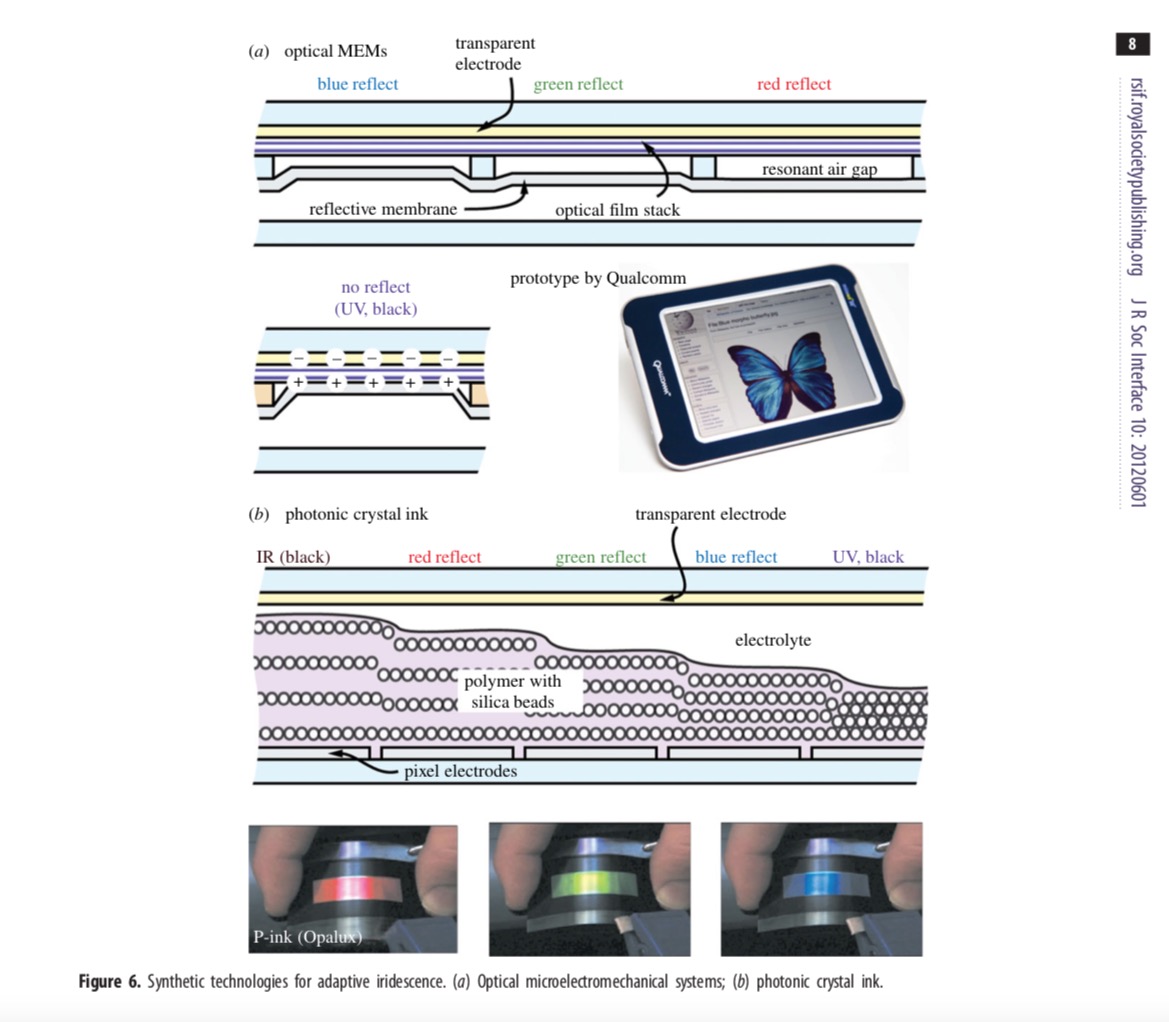
Photonic crystal displays (P-Ink)
(Structural Colors)
- Opalux
- Nanobrick
Photonic Crystals Display
Source: Review Paper: A critical review of the present and future prospects for electronic paper
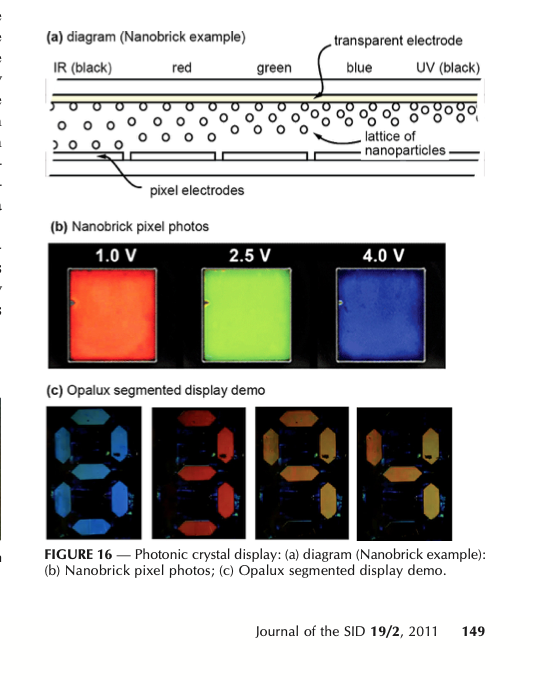
Source: Review Paper: A critical review of the present and future prospects for electronic paper
Photonic crystals refer to a class of structures that consist of periodic nanostructures with a spacing that interacts with the propagation of electromagnetic waves. Based on the spacing of the nanostructures, certain energy bands are allowed or forbidden for propagation, which can lead to the selective transmission or reflection of light. Dynamically changing the spacing of the nanostructures can change these propagation properties, leading to the modulation necessary to build a display. The term photonic crystal in displays is usually associated with three-dimensional periodic lattices, and the previously described MEMS interferometry (Sec. 1) is a special one-dimensional case of a photonic crystal.
Currently, there are two different photonic-crystal- based modulation approaches in development. Opalux is fabricating electrically color-tunable photonic crystals by embedding the lattices of 200-nm-diameter silica beads within an expandable electroactive polymer, which they call Photonic Ink or P-Ink.142 Opalux has demonstrated bistable P-Ink with a reflectance >50% and switching speed ~0.1 sec.143 The company has not described the viewing-angle dependence of their technology; photonic-crystal structures that possess highly regular crystal structures can show sharp dependences on illumination and viewing angles.
The company Nanobrick is developing systems that control the inter-particle distance of SiOx-encapsulated metal nanoparticles (20–30 wt.%) in electrophoretic colloidal suspension.144 These photonic crystal structures respond to signals of a few volts, shifting the reflected color through a continuous range as the average spacing changes. This enables full-spectrum tunability using a single electro-optic layer without requiring individual primary-color subpixels to generate color. It appears that the electrophoresis tends to randomize the structure somewhat, leading to reasonably wide viewing angles. Nanobrick has demonstrated a Color Tunable Photonic Crystal Display (CPD) with angle-independent optical responses (0–40°) using quasi-amorphous photonic pixels with response time <50 msec.145
While single-layer color tuning is a unique capability of the photonic-crystal approaches, the technology focus thus far has been limited to unit pixel or simple segments and still needs refinement in terms of the white state, reflectance vs. illumination condition, and demonstration with matrix addressing. Even though, in theory, colors such as red can be displayed at all pixels, white is still challenged because white will likely require additive display of side-by-side RGB pixels [similar to Fig. 2(b)]. Additionally, since pixels currently do not possess inherent gray scale, that means gray scale at the display level will require halftoning approaches.
Source: Stretchable and reflective displays: materials, technologies and strategies

Source: Stretchable and reflective displays: materials, technologies and strategies

Source: P-Ink and Elast-Ink from lab to market

Plasmonic Structural Colors Displays
Source: Dynamic plasmonic color generation enabled by functional materials
Structural colors, well known from coloration in nature (7), can overcome these limitations. Different from dyes and pigments, structural colors are generated by the interaction of light with micro- and nanostructures. Vibrant colors can be produced with the same materials (e.g., metals or dielectrics) by changing the geometries, dimensions, or arrangements of the structures through the fabrication process or even after fabrication (8). Compared to pigment or dye-based coloration, colors created in this case are much brighter due to their inherently high scattering/absorption efficiencies. As a result, thin layers, or more precisely tiny volumes, are sufficient for brilliant coloration. The benefit of these small coloration volumes is obvious. Ultrahigh-resolution images composed of subwavelength pixels with sizes down to the smallest coloring unit, e.g., a single micro- or nanostructure, can be printed (9). In addition, structural colors do not fade over time but provide a basically everlasting coloration due to the stability of the coloring structures. These appealing advantages have attracted great interest and stimulated intensive research on various structural coloration schemes based on metal nanostructures, dielectric metasurfaces, photonic crystals, and Fabry-Perot (FP) resonances (6, 10–17).
Source: Plasmonic Color Makes a Comeback
Plasmonic color is a subset of structural color, which is color resulting when the micro- or nanostructure of a material causes light scattering and interference. One form of structural color is the iridescent blue of the Morpho butterfly’s wings, whose scales have branched nanostructures that scatter light in complex ways. In plasmonic color, the color arises from light absorption and scattering off of the nanoparticles themselves. As with other forms of structural color, size, shape, and patterning create the color rather than chemical composition.
Source: Plasmonic Color Makes a Comeback
The Naval Research Laboratory’s Fontana has a different approach to making dynamic plasmonic displays: using self- assembled colloidal gold nanorods suspended in toluene. By placing an electric field across the suspension, the nanorods align in the direction of the applied field, producing intense plasmonic color, Fontana explains. The system is fast; it can switch at least 1,000 times as quickly as a conventional liquid-crystal pixel, potentially cutting down on motion blur, which is a problem with LCD displays.
Source: Plasmonic Color Makes a Comeback
In current commercial displays, each pixel is actually made of a red, green, and blue subpixel. Different amounts of light from each subpixel mix to create the perception of any color desired. One ambition for those developing plasmonic color systems is to flip one pixel between red, green, and blue rather than needing three separate subpixels that would require less space, allowing for much smaller pixels and higher definition screens. A system that can do just that has been created in the lab of Jeremy Baumberg at the University of Cambridge. It uses gold nanoparticles coated in the conducting polymer polyaniline and sprayed onto a flexible mirrored surface. The mirrored surface amplifies the plasmonic resonance, resulting in a more intense, uniform color with no viewing-angle dependence.
The color of each pixel is tuned by the reversible oxidation and reduction of the polymer, which changes the polymer’s refractive index and shifts the system’s plasmonic resonance. Each nanoparticle can theoretically be tuned independently, providing a potential spatial resolution of less than 100 nm. So far, the researchers have created pixels that switch only between red and green, but they are working on blue. Silver or aluminum particles could potentially show blue color, but “there is always a trade- off, as silver and aluminum materials are chemically [more] unstable [than gold],” says Hyeon-Ho Jeong, who formerly worked as a postdoc with Baumberg at Cambridge and is now at Gwangju Institute of Science and Technology.
Key Terms
- Plasmonic Metasurfaces
- Plasmonic Nanostructures
- Conjugated Polymers
- Plasmons
- Metallic Nanostructures
- Functional Materials
- Plasmonic Resonances
- Liquid Crystals plus plasmonic nanostructure
- Metal surface plasmonics
- Nanowire waveguides
- Meta-materials
- Quantum dots (QDs)
- Nano Hole Array NHA
- Dielectric Metasurfaces
- Tunable Color Filters
- Metal-Insulator-Metal Resonators (MIM)
- Sub Wavelength Grating SWG
- Subwavelength metal–insulator–metal stack arrays
- Nanowire Color Filter
- Metasurface Color Filter
- Quantum Dot Color Filter
- Plasmonic hole array color filters
- Debashis Chanda, a nanophotonics scientist at the University of Central Florida
- E-skin Displays, in 2017
Source: Plasmonic Metasurfaces with Conjugated Polymers for Flexible Electronic Paper in Color

Transmissive Displays
Emmisive Displays
- LED
- True QLED
- OLED
- AM-OLED
- Mini-LED
- Micro LED
All QLED panels are made by Samsung. QLED really is LCD panel It requires back lighting.
All OLED panels are made by LG Displays.
Please see my post on LCD and LED displays.
Transmitive Displays
- LCD
- AM LCD
- PMLCD
Please see my post on LCD and LED displays.
Transmissive liquid crystal displays (LCDs) have been widely used in laptop computers, desktop monitors, and high-definition televisions (HDTVs).
TFT- AMLCD
Source: Review of Display Technologies Focusing on Power Consumption
In AMLCD, a switch is placed at each pixel which decouples the pixel-selection function. Thin Film Transistor (TFT), the main technology of the AMLCD subgroup, can also be divided regarding the material used for its elaboration, into amorphous silicon (a-Si), continuous grain silicon (CGS) and low temperature polycrystalline silicon (LTPS TFT). A new approach is the indium-gallium-zinc- oxide (IGZO) technology developed by Sharp.
Another issue to take into account is the liquid crystal alignment mode, where Twisted Nematic (TN) and Super-Twisted Nematic (STN) types are the simplest and least expensive, but offering a poor viewing angle (of approx. 45 degrees). Vertical Alignment (VA) technology generally appears under various trade names (ASV by Sharp, PVA by Samsung, etc.) and tries to improve the viewing angle of the device (for instance, Ampire VA device offers 160 degrees versus the 45 of the TN device by AUO). In-plane switching (IPS TFT), as the Hitachi module from the table shows, also has a better viewing angle than TN and the color and contrast is also improved.
My related posts
On Light, Vision, Appearance, Color and Imaging
Color and Imaging in Digital Video and Cinema
Growth and Form in Nature: Power Laws and Fractals
On Luminescence: Fluorescence, Phosphorescence, and Bioluminescence
Color Change: In Biology and Smart Pigments Technology
Optics of Metallic and Pearlescent Colors
Nature’s Fantastical Palette: Color From Structure
Color Science and Technology in LCD and LED Displays
Key Sources of Research
CLEARink
Waveshare
A Review of Electronic Paper Display Technologies from the Standpoint of SID Symposium Digests
Tatsumi Takahashi
TCL NXTPAPER wants to compete against E INK
September 3, 2020 By Michael Kozlowski
Review of Paper-Like Display Technologies
Peng Fei Bai1, Robert A. Hayes1, Ming Liang Jin1, Ling Ling Shui1, Zi Chuan Yi1, L. Wang1, Xiao Zhang1, and Guo Fu Zhou1, 2
Progress In Electromagnetics Research, Vol. 147, 95–116, 2014
Stretchable and reflective displays: materials, technologies and strategies
Nano Convergence volume 6, Article number: 21 (2019)
https://nanoconvergencejournal.springeropen.com/articles/10.1186/s40580-019-0190-5
Review Paper: A critical review of the present and future prospects for electronic paper
Jason Heikenfeld (SID Senior Member) Paul Drzaic (SID Fellow)
Jong-Souk Yeo (SID Member)
Tim Koch (SID Member)
Journal of the SID 19/2, 2011
Electrowetting-Based Displays: Bringing Microfluidics Alive On-Screen
B. J. Feenstra1, R. A. Hayes, R. van Dijk, R. G. H. Boom, M. M. H. Wagemans, I. G. J. Camps, A. Gi- raldo and B. v.d. Heijden
Philips Research Laboratories, Prof. Holstlaan 4, 5656 AA, Eindhoven, The Netherlands
Biological versus electronic adaptive coloration: how can one inform the other?
Eric Kreit1, Lydia M. Ma ̈thger2, Roger T. Hanlon2, Patrick B. Dennis3, Rajesh R. Naik3, Eric Forsythe4 and Jason Heikenfeld1
J R Soc Interface 10: 20120601.
https://royalsocietypublishing.org/doi/pdf/10.1098/rsif.2012.0601
Transmissive/Reflective Structural Color Filters: Theory and Applications
Yan Yu,1,2 Long Wen,2 Shichao Song,2 and Qin Chen
Volume 2014 |Article ID 212637 | https://doi.org/10.1155/2014/212637
https://www.hindawi.com/journals/jnm/2014/212637/
Interferometric modulator display
https://en.wikipedia.org/wiki/Interferometric_modulator_display
Qualcomm resurrects Mirasol reflective displays with new 576 ppi smartphone panel
https://www.theverge.com/2013/5/22/4354642/high-res-mirasol-display-for-smartphones-demonstrated
Iridescence-controlled and flexibly tunable retroreflective structural color film for smart displays
- Wen Fan
- Jing Zeng
- Qiaoqiang Gan
- Dengxin Ji
- Haomin Song
- Wenzhe Liu
- Lei Shi
- Limin Wu
Science Advances 09 Aug 2019:
Vol. 5, no. 8, eaaw8755
DOI: 10.1126/sciadv.aaw8755
https://advances.sciencemag.org/content/advances/5/8/eaaw8755.full.pdf
Artificial Structural Color Pixels: A Review
by Yuqian Zhao 1, Yong Zhao 1,*, Sheng Hu 1, Jiangtao Lv 1, Yu Ying 2, Gediminas Gervinskas 3 and Guangyuan Si
Materials 2017, 10(8), 944; https://doi.org/10.3390/ma10080944
https://www.mdpi.com/1996-1944/10/8/944/htm
Dynamically Tunable Plasmonic Structural Color
Daniel Franklin
University of Central Florida 2018
PHD Thesis
https://stars.library.ucf.edu/cgi/viewcontent.cgi?article=6880u0026amp;context=etd
Colors with plasmonic nanostructures: A full-spectrum review
Applied Physics Reviews 6, 041308 (2019); https://doi.org/10.1063/1.5110051
https://aip.scitation.org/doi/abs/10.1063/1.5110051?journalCode=are
Dynamic plasmonic color generation enabled by functional materials
Frank Neubrech1,2, Xiaoyang Duan1,2, Na Liu3,4*
Bright and Vivid Diffractive–Plasmonic Reflective Filters for Color Generation
- Emerson G. Melo,
- Ana L. A. Ribeiro,
- Rodrigo S. Benevides,
- Antonio A. G. V. Zuben,
- Marcos V. Puydinger dos Santos,
- Alexandre A. Silva,
- Gustavo S. Wiederhecker, and
- Thiago P. M. Alegre*
ACS Appl. Nano Mater. 2020, 3, 2, 1111–1117Publication Date:December 31, 2019 https://doi.org/10.1021/acsanm.9b02508
https://pubs.acs.org/doi/full/10.1021/acsanm.9b02508
Active control of plasmonic colors: emerging display technologies
Kunli Xiong, Daniel Tordera, Magnus Jonsson and Andreas B. Dahlin
Rep Prog Phys. 2019 Feb;82(2):024501.
doi: 10.1088/1361-6633/aaf844.
https://pubmed.ncbi.nlm.nih.gov/30640724/
Self-assembled plasmonics for angle-independent structural color displays with actively addressed black states
Daniel Franklina,b, Ziqian Hec, Pamela Mastranzo Ortegab, Alireza Safaeia,b, Pablo Cencillo-Abadb, Shin-Tson Wuc, and Debashis Chandaa,b,c,1
https://www.pnas.org/content/117/24/13350
Bio-inspired intelligent structural color materials
Luoran Shang, Weixia Zhang, Ke Xuc and Yuanjin Zhao
Mater. Horiz., 2019,6, 945-958
https://pubs.rsc.org/en/content/articlelanding/2019/mh/c9mh00101h#!divAbstract
Advanced Plasmonic Materials for Dynamic Color Display
- November 2017
- Advanced Materials 30(16):1704338
Polarization-independent actively tunable colour generation on imprinted plasmonic surfaces
- Daniel Franklin,
- Yuan Chen,
- Abraham Vazquez-Guardado,
- Sushrut Modak,
- Javaneh Boroumand,
- Daming Xu,
- Shin-Tson Wu &
- Debashis Chanda
Nature Communications volume 6, Article number: 7337 (2015)
https://www.nature.com/articles/ncomms8337
Tunable plasmonic color filter
Rosanna Mastria, Karl Jonas Riisnaes, Monica Craciun, and Saverio Russo
Frontiers in Optics / Laser Science OSA Technical Digest (Optical Society of America, 2020),paper JTh4B.7•
https://doi.org/10.1364/FIO.2020.JTh4B.7
https://www.osapublishing.org/abstract.cfm?uri=FiO-2020-JTh4B.7
Reflective Display Technology
Samsung 2017
https://pid.samsungdisplay.com/en/learning-center/blog/reflective-display-technology
Modeling of Oil/Water Interfacial Dynamics in Three-Dimensional Bistable Electrowetting Display Pixels
Guisong Yang, Lei Zhuang, Pengfei Bai,* Biao Tang, Alex Henzen, and Guofu Zhou
CS Omega 2020, 5, 10, 5326–5333Publication Date:March 3, 2020https://doi.org/10.1021/acsomega.9b04352
https://pubs.acs.org/doi/10.1021/acsomega.9b04352
The E-Paper Revolution Has Begun
Mon, September 09, 2019
https://www.radiantvisionsystems.com/blog/e-paper-revolution-has-begun
Global E-Paper Display Market Growth Prospects, Key Vendors, Future Scenario Forecast To 2027 | CLEARink Displays, Inc., E Ink Holdings Inc
07-07-2020
https://www.openpr.com/news/2086154/global-e-paper-display-market-growth-prospects-key-vendors
e-Paper Display Markets 2016-2024: e-Readers, Signage/Poster Devices, Mobile Phones, & Others – Global Analysis, Trends, and Forecasts Report 2019
2019
Worldwide E-Paper Display Market Share, Growth, Statistics, by Application, Production, Revenue & Forecast up to 2027
Clearink Displays
https://www.clearinkdisplays.com/about-us
What Happened to Liquavista Electrowetting Display?
https://lookgadgets.com/liquavista/
Etulipa brings its electrowetting display off-the-grid
23 October 2019
BART BROUWERS
How Electronic Ink Was Invented
OLED vs. LED: Which kind of TV display is better?
By Michael Bizzaco , Simon Cohen and Tyler LacomaJanuary 21, 2021
https://www.digitaltrends.com/home-theater/oled-vs-led/
E-INK AND E-PAPER: A HISTORY, ROOM SIGNS AND MORE
https://www.visix.com/resources/blog/e-ink-and-e-paper-a-history-room-signs-and-more/
11 Myths About E-paper Displays
Good E Reader.com
DKE E PAPER Manufacturer
E Ink.com
Pervasive Displays
https://www.pervasivedisplays.com
World’s Largest ePaper E Ink Sign Unveiled at UN Headquarters
https://www.mpicosys.com/news/worlds-largest-epaper-e-ink-sign-unveiled-un-headquarters/
ONYX BOOX
Plastic Logic
E Paper Displays Explained
E Ink, Innolux deliver 28-inch ePaper
https://www.digitalsignagetoday.com/news/e-ink-innolux-deliver-28-inch-epaper/
E Ink and Plastic Logic Partner to Provide the World’s First Flexible Advanced Color ePaper (ACeP™)-Based Display
Ossia, E-PEAS, and E Ink Debut E-Paper Electronic Shelf Label Powered by Wireless Energy Harvesting
July 28, 2019 by Scott McMahan
PicoSign
Visionect and E Ink Launch Prototyping System for Developing Large-Format ePaper Signs
the-ebook-reader.com
https://www.the-ebook-reader.com/e-ink.html
Electronic Ink
http://www2.units.it/ramponi/teaching/DIP/materiale/z04_disp_e-ink.pdf
E -Ink
Invited Paper: TFT Technologies for Flexible Displays
Jin Jang Min Hee Choi Jun Hyuk Cheon
First published: 05 July 2012
https://doi.org/10.1889/1.3499860
https://onlinelibrary.wiley.com/doi/abs/10.1889/1.3499860
A Review In Preparation of Electronic Ink for Electrophoretic Displays
S.KholghiEshkalak*, M.Khatibzadeh
PROCEEDINGS OF THE INTERNATIONAL CONFERENCE NANOMATERIALS:APPLICATIONS AND PROPERTIES
Vol.3 No2,02 NAESF06 (5pp)(2014)
https://core.ac.uk/reader/141442140
Flexible Electronics Development in Taiwan
Dr. Janglin (John) Chen
Vice President & General Director Display Technology Center
ITRI
2010
TFT Technology for Flexible Display Applications
Chang-Dong Kim, In Byeong Kang, and In-Jae Chung
LCD R&D Center, LG.Philips LCD, 533, Hogae-dong, Dongan-gu, Anyang-shi, Kyoungki-do, 431-080, KOREA
Progress and Challenges in Commercialization of Organic Electronics
Yueh-Lin Loo and Iain McCulloch, Guest Editors
MRS BULLETIN • VOLUME 33 • JULY 2008
Evaluating Display Reflections in Reflective Displays and Beyond
https://onlinelibrary.wiley.com/doi/pdf/10.1002/msid.1099
Active Matrix Electrophoretic E-Book Display
Guofu Zhou1 and Mark Johnson
Philips Research, High Tech Campus, Building 34, Eindhoven 5656 AE, The Netherlands
Karl Amundson and Robert W Zehner
E Ink Corporation, 733 Concord Avenue, Cambridge, MA 02138 USA
Alex Henzen and Jan van de Kamer
IRex Technologies BV, High Tech Campus, Building 46, Eindhoven 5656 AE, The Netherlands
Inkjet-printed polymer-based electrochromic and electrofluorochromic dual-mode displays†
Manuel Pietsch, Tobias Rödlmeier, Stefan Schlisske
Johannes Zimmermann, Carlos Romero-Nieto and Gerardo Hernandez-Sosa
J. Mater. Chem. C, 2019, 7, 7121
https://pubs.rsc.org/en/content/articlehtml/2019/tc/c9tc01344j
Invited Paper: International Standards Development of Electronic Paper Displays
First published: 29 May 2019
SID Volume50, Issue1
June 2019
Pages 398-401
https://onlinelibrary.wiley.com/doi/abs/10.1002/sdtp.12941
Dyed Polymeric Microparticles for Colour Rendering in Electrophoretic Displays
Mark Goulding, Louise Farrand, Ashley Smith, Nils Greinert, Henry Wilson, Claire Topping, Roger Kemp, Emily Markham, Mark James, Johannes Canisius, Dan Walker
Merck Chemicals Ltd., Advanced Technologies, Chilworth Technical Centre, University Parkway, Southampton, Hampshire, SO16 7QD, UK
Richard Vidal, Sihame Khoukh
Merck Chimie, Center Production ESTAPOR, Zone Industrielle, Rue du Moulin de la Canne, 45 300 Pithiviers, France.
Seung-Eun Lee, Hee-Kyu Lee
Merck Advanced Technologies, Poseung Technical Center, 1173-2 Wonjyung-ri, Poseung-myun, Pyungtaek-si, Kyungki-do, Korea
E-paper Display (EPD) Market Size 2020-2024 Industry News Analysis, Upstream Raw Material Suppliers, Major Players and Product Types
2020
E Ink Holdings, electronic ink technology, and Fujitsu Semiconductor have developed a reference design board for battery-less ePaper tags using E Ink’s ePaper and Fujitsu’s UHF (Ultra High Frequency) band.
Printing Technologies for Organic TFT Array for Electronic Paper
Ryohei Matsubara, Yukari Harada, Kaoru Hatta,
Takumi Yamamoto, Manabu Takei, Mamoru Ishizaki,
Mitsuyoshi Matsumura, Kenich Ota, and Manabu Ito
Display Research Laboratory, Technical Research Institute, Toppan Printing Co., Ltd., Saitama, Japan
CYM and RGB colored electronic inks based on silica-coated organic pigments for full-color electrophoretic displays
Peipei Yin,aGang Wu,*aWenlong Qin,aXiaoqiang Chen,aMang Wanga and Hongzheng Chen*a
https://pubs.rsc.org/no/content/articlelanding/2013/tc/c2tc00344a/unauth#!divAbstract
Hisense A7CC 5G smartphone integrates a 6.7-inch color E-Ink display
Bistable electrowetting displays
Karlheinz Blankenbach
Juergen Rawert
January 2011
DOI: 10.1117/2.1201012.003407
https://www.researchgate.net/publication/315169299_Bistable_electrowetting_displays
Current commercialization status of electrowetting-on-dielectric (EWOD) digital microfluidics
Jia Li and Chang-Jin “CJ” Kim
Lab Chip, 2020,20, 1705-1712
https://pubs.rsc.org/en/content/articlelanding/2020/lc/d0lc00144a/unauth#!divAbstract
The complete history of E INK Color E-Paper
November 22, 2020
A Short History of E-Paper and the eReader Revolution
August 11, 2017 By Michael Kozlowski
https://goodereader.com/blog/electronic-readers/a-short-history-of-e-ink-and-the-ereader-revolution
A Short History of E-Ink: How E Ink managed to become the last man standing and dominated the e-reader revolution!
by Michael Kozlowski
book
2018
Electrochromic Plasmonic Metasurfaces for Reflective Displays
By Kunli Xiong
2017
https://core.ac.uk/display/128708224
Switching Colors with Electricity
BY ROGER J. MORTIMER
https://www.americanscientist.org/article/switching-colors-with-electricity
MicroLED vs OLED: the battle of the high-end display tech
Can the next-gen TV tech microLED beat out OLED?
https://www.techradar.com/news/microled-vs-oled-the-battle-of-the-high-end-display-tech
OLED vs QLED: the premium TV panel technologies compared
https://www.techradar.com/news/oled-vs-qled
LG’s new ‘QNED’ TVs will have up to nearly 30,000 tiny LEDs behind the screen
The Verge
https://www.theverge.com/2020/12/28/22203910/lg-qned-mini-led-4k-8k-lcd-tv-announced-ces-2021
Performance of reflective color displays in Out Of Home applications
ETulipa
Plasmonic Color Makes a Comeback
ACS Cent. Sci. 2020, 6, 332−335
https://pubs.acs.org/doi/pdf/10.1021/acscentsci.0c00259
Structural Colors for Display and E-paper Applications
L. Jay Guo
Department of Electrical Engineering and Computer Science The University of Michigan, Ann Arbor, Michigan, USA
Stretchable and reflective displays: materials, technologies and strategies
Nano Convergence volume 6, Article number: 21 (2019)
https://nanoconvergencejournal.springeropen.com/articles/10.1186/s40580-019-0190-5
Transmissive/Reflective structural color filters: theory and applications
Journal of Nanomaterials January 2014 Article No.: 6 https://doi.org/10.1155/2014/212637
https://dl.acm.org/doi/abs/10.1155/2014/212637
https://dl.acm.org/doi/pdf/10.1155/2014/212637
Plasmonic Metasurfaces with Conjugated Polymers for Flexible Electronic Paper in Color
Kunli Xiong, Gustav Emilsson, Ali Maziz, Xinxin Yang, Lei Shao, Edwin W. H. Jager and Andreas B. Dahlin.
Reflective–emissive photoluminescent cholesteric liquid crystal display
Jang-Kyum Kim, Suk-Hwan Joo, and Jang-Kun Song
Applied OpticsVol. 52,Issue 34,pp. 8280-8286(2013)
Mobile Displays: Technology and Applications
edited by Achintya K. Bhowmik, Zili Li, Philip J. Bos
Book
Reflective cholesteric liquid crystal displays
D.-K. Yang Kent State Univ
in Mobile Displays,
Reflective and Transflective Liquid Crystal Displays
- September 2014
DOI: 10.1002/9781118751992.ch9
- In book: Fundamentals of Liquid Crystal Devices, Second Edition (pp.285-319)
Deng‐Ke Yang
Shin-Tson Wu
Full-color reflective display based on narrow bandwidth templated cholesteric liquid crystal film
- December 2016
- Optical Materials Express 7(1):16
DOI: 10.1364/OME.7.000016
Electrophoretic liquid crystal displays: How far are we?
Susanne Klein
HP Laboratories HPL-2013-23
How Liquid Crystal Displays Work in an eWriter
By Monica Kanojia May 04, 2012
https://www.livescience.com/20104-boogie-board-ewriter-nsf-bts.html
Dynamic plasmonic color generation enabled by functional materials
- Frank Neubrech
- Xiaoyang Duan
- Na Liu
Science Advances 04 Sep 2020:
Vol. 6, no. 36, eabc2709
DOI: 10.1126/sciadv.abc2709
https://advances.sciencemag.org/content/6/36/eabc2709
Reflective Liquid Crystal Displays
Shin-Tson Wu, Hughes Research Laboratories
Deng-ke Yang, Kent State University
The evolution of portable communications applications has been facilitated largely by the development of reflective LCD technology. Offering a unique insight into state-of-the art display technologies, Reflective Liquid Crystal Displays covers the basic operations principles, exemplary device structures and fundamental material properties of device components.
Featuring:
- Direct-view, projection and micro (virtual projection) reflective displays in the context of multi-media projectors, mobile internet and personal entertainment displays.
- Optimization of critical display attributes: fast response time, low voltage operation and wide angle viewing.
- Description of the basic properties of liquid crystal materials and their incorporation into configurations for transmissive and reflective applications.
- Examination of the various operations modes enabling the reader to select the appropriate display type to meet a variety of needs.
- Overview and comparison of the complete range of reflective display technologies, and reflective LCD effects.
Product Demographics
Author: Shin-Tson Wu, Deng-Ke Yang
Publisher: John Wiley & Sons, Ltd
Date of Publication: 04/01/2001
ISBN Number: 0-471-49611-1
Format: Hardback
Pages: 352
Reflective liquid crystal display with fast response time and wide viewing angle
Xiao-Qing GuaFan ChuaLi-Lan TianaRui LiaWen-Yi HouaXiang-Yu Zhoua Qiong-HuaWang
Received 29 August 2019, Revised 5 November 2019, Accepted 16 November 2019, Available online 20 November 2019.
Optics Communications. Volume 459, 15 March 2020, 124970
https://www.sciencedirect.com/science/article/abs/pii/S0030401819310466
RDot AB ElectroChromic Displays
https://rdotdisplays.com/displays
Review of nanostructure color filters Felix Gildas and Yaping Dan*
University of Michigan–Shanghai Jiao Tong University Joint Institute, Shanghai, China
J. Nanophoton. 13(2), 020901 (2019), doi: 10.1117/1.JNP.13.020901.
http://yapingd.sjtu.edu.cn/upload/editor/file/20190708/20190708084242_36263.pdf
Nanostructured Color Filters: A Review of Recent Developments
Ayesha Shaukat 1,2 , Frazer Noble 1 and Khalid Mahmood Arif 1,*
Received: 21 June 2020; Accepted: 23 July 2020; Published: 7 August 2020
Liquid-crystal tunable color filters based on aluminum metasurfaces
Zu-Wen Xie, Jhen-Hong Yang, Vishal Vashistha, Wei Lee, and Kuo-Ping Chen
Optics Express > Volume 25 > Issue 24 > Page 30764
Structural Colors: From Plasmonic to Carbon Nanostructures
Ting XuHaofei ShiYi‐Kuei WuAlex F. KaplanJong G. OkL. Jay Guo
First published: 20 September 2011
Small, 7, 3128 (2011)
https://doi.org/10.1002/smll.201101068
A New Full Color Reflective Display Based on Cholesteric Liquid Crystals
Reflective Display Technology
22 Dec 2017 Samsung
https://pid.samsungdisplay.com/en/learning-center/blog/reflective-display-technology
Electrochromic Displays
Kobayashi N. (2015)
In: Chen J., Cranton W., Fihn M. (eds) Handbook of Visual Display Technology. Springer, Berlin, Heidelberg.
https://doi.org/10.1007/978-3-642-35947-7_188-1
Transparent inorganic multicolour displays enabled by zinc-based electrochromic devices
Light: Science & Applicationsvolume 9, Article number: 121 (2020)
https://www.nature.com/articles/s41377-020-00366-9
Electrochromic Device
https://www.sciencedirect.com/topics/materials-science/electrochromic-device
What is an Electrochromic Display?
Ynvisible
https://www.ynvisible.com/news-inspiration/what-is-an-electrochromic-display
Rollable and transparent subpixelated electrochromic displays using deformable nanowire electrodes with improved electrochemical and mechanical stability
Jong-WooKimDo-KyunKwonJae-MinMyoung
Department of Materials Science and Engineering, Yonsei University, 50 Yonsei-ro, Seodaemun-gu, Seoul 03722, Republic of Korea
Received 22 November 2019, Revised 26 December 2019, Accepted 15 January 2020, Available online 18 January 2020.
https://doi.org/10.1016/j.cej.2020.124145
https://www.sciencedirect.com/science/article/abs/pii/S1385894720301364
Performance studies of electrochromic displays
Proceedings Volume 9258, Advanced Topics in Optoelectronics, Microelectronics, and Nanotechnologies VII; 925833 (2015)
https://doi.org/10.1117/12.2072317
Flexible and Transparent Electrochromic Displays with Simultaneously Implementable Subpixelated Ion Gel‐Based Viologens by Multiple Patterning
First published: 04 February 2019
https://doi.org/10.1002/adfm.201808911
https://onlinelibrary.wiley.com/doi/abs/10.1002/adfm.201808911
Greyscale and Paper Electrochromic Polymer Displays by UV Patterning
by Robert Brooke 1,2, Jesper Edberg 1,2, Xavier Crispin 1, Magnus Berggren 1, Isak Engquist 1 and Magnus P. Jonsson 1,*1
Laboratory of Organic Electronics, Department of Science and Technology, Linkoping University, SE-601 74 Norrkoping, Sweden2RISE Acreo, ICT Department, Printed Electronics, Research Institutes of Sweden, Acreo, 601 17 Norrkoping, Sweden
Polymers2019, 11(2), 267; https://doi.org/10.3390/polym11020267
https://www.mdpi.com/2073-4360/11/2/267
Printed Electrochromics boldly goes where no display has gone before
https://www.oled-info.com/printed-electrochromics-boldly-goes-where-no-display-has-gone
Multi-Layered Electrochromic Display
Yoshihisa Naijoh, Tohru Yashiro, Shigenobu Hirano, Yoshinori Okada, SukChan Kim, Kazuaki Tsuji, Hiroyuki Takahashi, Koh Fujimura, Hitoshi Kondoh
RICOH Company, Ltd., Research and Development Group, 16-1 Shinei-cho, Tsuzuki-ku, Yokohama-shi, Kanagawa, Japan
High Resolution Technology for Multi-Layered Electrochromic Display
Yoshinori Okada, Tohru Yashiro, Yoshihisa Naijoh, Shigenobu Hirano, SukChan Kim, Kazuaki Tsuji, Hiroyuki Takahashi, Koh Fujimura, Hitoshi Kondoh
RICOH Company, Ltd., Research and Development Group, 16-1 Shinei-cho, Tsuzuki-ku, Yokohama, Kanagawa, Japan
Flexible Electrochromic Display
Tohru Yashiro, Yoshinori Okada, Yoshihisa Naijoh, Shigenobu Hirano, Toshiya Sagisaka, Daisuke Gotoh, Mamiko Inoue, SukChan Kim, Kazuaki Tsuji, Hiroyuki Takahashi, and Koh Fujimura
RICOH Company, Ltd., Research and Development Group, 16-1 Shinei-cho, Tsuzuki-ku, Yokohama, Kanagawa, Japan
5.3: Novel Design for Color Electrochromic Display
Tohru Yashiro, Shigenobu Hirano, Yoshihisa Naijoh, Yoshinori Okada, Kazuaki Tsuji, Mikiko Abe, Akishige Murakami, Hiroyuki Takahashi, Koh Fujimura, Hitoshi Kondoh
Ricoh Company, Ltd., Research and Development Group 16-1 Shinei-cho, Tsuzuki-ku Yokohama, Kanagawa, Japan
Electrokinetic pixels with biprimary inks for color displays and color-temperature-tunable smart windows
S. MUKHERJEE,1 W. L. HSIEH,3 N. SMITH,2 M. GOULDING,2 AND J. HEIKENFELD1,*
1Department of Electrical Engineering and Computing Systems, University of Cincinnati, Cincinnati, Ohio 45221, USA 2Merck Chemicals Ltd., Chilworth Technical Centre, Southampton, Hampshire SO16 7QD, UK
3Institute of Applied Mechanics, National Taiwan University, Taipei 106, Taiwan
*Corresponding author: heikenjc@ucmail.uc.edu
Received 11 March 2015; revised 5 May 2015; accepted 11 May 2015; posted 18 May 2015 (Doc. ID 235176); published 10 June 2015
Vol. 54, No. 17 / June 10 2015 / Applied Optics
TransPrint: A Method for Fabricating Flexible Transparent Free-Form Displays
Walther Jensen,1 Ashley Colley,2 Jonna Häkkilä,2 Carlos Pinheiro,3 and Markus Löchtefeld1
1Aalborg University, 9000 Aalborg, Denmark
2University of Lapland, 96300 Rovaniemi, Finland
3Ynvisible Interactive Inc., 2820-690 Charneca da Caparica, Portugal
Advances in Human-Computer Interaction, vol. 2019, Article ID 1340182, 14 pages,2019. https://doi.org/10.1155/2019/1340182
https://www.hindawi.com/journals/ahci/2019/1340182/
IllumiPaper: Illuminated Interactive Paper
Konstantin Klamka, Raimund Dachselt
Interactive Media Lab Dresden Technische Universita ̈t Dresden, Germany {klamka, dachselt}@acm.org
Electrofluidic Imaging Films for Brighter, Faster, and Lower‐Cost e‐Paper
Matthew Hagedon Jason Heikenfeld Kenneth A. Dean Eric Kreit Kaichang Zhou John Rudolph
First published: 01 July 2013
SID
Volume44, Issue1 June 2013 Pages 111-114
https://doi.org/10.1002/j.2168-0159.2013.tb06154.x
https://onlinelibrary.wiley.com/doi/abs/10.1002/j.2168-0159.2013.tb06154.x
The Biprimary Color System for E‐Paper: Doubling Color Performance Compared to RGBW
Sayantika Mukherjee Jason Heikenfeld Nathan Smith Mark Goulding Claire Topping Sarah Norman Qin Liu Laura Kramer
Volume45, Issue1 San Diego, CA, June 1–6, 2014
June 2014 Pages 869-872. First published: 07 July 2014
https://doi.org/10.1002/j.2168-0159.2014.tb00229.x
https://onlinelibrary.wiley.com/doi/abs/10.1002/j.2168-0159.2014.tb00229.x
Fundamentals and Applications of Large Area Multi-spectral state Electrophoretic Panels for Displays and Smart Windows
PhD Thesis 2015
Sayantika Mukherjee
Printed Multi-color Devices using Oxidative Electrochromic Materials
Daisuke Goto*, Satoshi Yamamoto, Toshiya Sagisaka, Masato Shinoda, Fuminari Kaneko, Keiichiro Yutani, Keigo Takauji, Yoshinori Okada, and Tohru Yashiro
Ricoh Institute of Future Technology, Ricoh Co., Ltd.
16-1 Shinei-cho, Tsuduki-ku, Yokohama, Kanagawa 224-0035, Japan
*daisuke.dg.gotoh@nts.ricoh.co.jp
Journal of Photopolymer Science and Technology
Volume 30, Number 4 (2017) 489-493
https://www.jstage.jst.go.jp/article/photopolymer/30/4/30_489/_pdf
Novel organic multi-color electrochromic device for e-paper application
Authors: Kobayashi, Norihisa; Yukikawa, Masahiro; Liang, Zhuang; Nakamura, Kazuki
Source: NIP & Digital Fabrication Conference, Volume 2017, Number 1, November 2017, pp. 111-114(4)
Publisher: Society for Imaging Science and Technology
https://www.ingentaconnect.com/contentone/ist/nipdf/2017/00002017/00000001/art00026
Scalable electrochromic nanopixels using plasmonics
- Jialong Peng
- Hyeon-Ho Jeong
- Qianqi Lin
- Sean Cormier1,
- Hsin-Ling Liang2,
- Michael F. L. De Volder2,
- Silvia Vignolini3 and
- Jeremy J. Baumberg1,†
- 1NanoPhotonics Centre, Cavendish Laboratory, University of Cambridge, Cambridge CB3 0HE, UK.
- 2NanoManufacturing Group, Department of Engineering, University of Cambridge, Cambridge CB3 0FS, UK.
- 3Bio-inspired Photonics Group, Department of Chemistry, University of Cambridge, Cambridge CB2 1EW, UK.
Science Advances 10 May 2019:
Vol. 5, no. 5, eaaw2205
DOI: 10.1126/sciadv.aaw2205
https://advances.sciencemag.org/content/5/5/eaaw2205
Electrochromic display
Innoscentia adopts Ynvisible displays for dynamic food labels
https://www.e-ink-info.com/tags/electrochromic-display
Low energy switching driver for printed electrochromic displays
Ciprian Ionescu, Robert Alexandru Dobre
Proceedings Volume 10010, Advanced Topics in Optoelectronics, Microelectronics, and Nanotechnologies VIII; 100100I (2016) https://doi.org/10.1117/12.2246104
Event: Advanced Topics in Optoelectronics, Microelectronics, and Nanotechnologies 2016, 2016, Constanta, Romania
Electrochromic materials and devices: present and future
Prakash R. Somani a,∗, S. Radhakrishnan b
a Photonics and Advanced Materials Laboratory, Centre for Materials for Electronics Technology (C-MET), Panchawati, Off Pashan Road, Pune 411008, India
b National Chemical Laboratory (NCL), Polymer Science and Chemical Engineering, Pune 411008, India
Received 17 May 2001; received in revised form 10 September 2001; accepted 26 September 2001
Materials Chemistry and Physics 77 (2002) 117–133
A high speed electrically switching reflective structural color display with large color gamut
Wenqiang Wang,aZhiqiang Guan *a and Hongxing Xu*ab
Nanoscale, 2021,13, 1164-1171
https://pubs.rsc.org/en/content/articlelanding/2021/nr/d0nr07347d/unauth#!divAbstract
Mechanochromism in Structurally Colored Polymeric Materials
Jess M. Clough,* Christoph Weder, and Stephen Schrettl
Macromol. Rapid Commun. 2021, 42, 2000528
https://onlinelibrary.wiley.com/doi/full/10.1002/marc.202000528
Transparent inorganic multicolour displays enabled by zinc-based electrochromic devices
by Light Publishing Center, Changchun Institute of Optics, Fine Mechanics And Physics, Chinese Academy
https://phys.org/news/2020-07-transparent-inorganic-multicolour-enabled-zinc-based.html
Transparent inorganic multicolour displays enabled by zinc-based electrochromic devices
Light: Science & Applications volume 9, Article number: 121 (2020)
https://www.nature.com/articles/s41377-020-00366-9
The Rdot Display
https://rdotdisplays.com/displays#technology-overview
Flexible displays for smart clothing: Part II— Electrochromic displays
Ludivine Meunier, Fern M. Kelly, V. Koncar
Published 2011
Electrochromic displays
The new black
Nature Materials volume 7, pages766–767(2008)
https://www.nature.com/articles/nmat2282
Intrinsically stretchable polymer based electrochromic devices for soft electronic displays
Preston, Garth Eden Claire
2020 PhD Thesis UBC, Canada
https://open.library.ubc.ca/cIRcle/collections/ubctheses/24/items/1.0394053
TiO2 Nanostructured Films for Electrochromic Paper Based-Devices
by Daniela Nunes , Tomas Freire, Andrea Barranger 1, João Vieira 1, Mariana Matias 1, Sonia Pereira 1, Ana Pimentel 1, Neusmar J. A. Cordeiro 1,2, Elvira Fortunato 1 and Rodrigo Martins 1,
Appl. Sci. 2020, 10(4), 1200; https://doi.org/10.3390/app10041200
https://www.mdpi.com/2076-3417/10/4/1200/htm
Printable All‐Organic Electrochromic Active‐Matrix Displays
P. Andersson R. Forchheimer P. Tehrani M. Berggren
First published: 31 August 2007
https://doi.org/10.1002/adfm.200601241
Advanced Functional Materials Volume17, Issue16
November, 2007
Pages 3074-3082
https://onlinelibrary.wiley.com/doi/epdf/10.1002/adfm.200601241
Development and Manufacture of Polymer‐Based Electrochromic Devices
Jacob Jensen Markus Hösel Aubrey L. Dyer Frederik C. Krebs
Advanced Functional Materials Volume25, Issue14
April 8, 2015
Pages 2073-2090
First published: 26 February 2015 https://doi.org/10.1002/adfm.201403765
https://onlinelibrary.wiley.com/doi/abs/10.1002/adfm.201403765
In-Glass Display Applications
Lumineq
Greyscale and Paper Electrochromic Polymer Displays by UV Patterning
by Robert Brooke 1,2, Jesper Edberg 1,2, Xavier Crispin 1, Magnus Berggren 1, Isak Engquist 1 and Magnus P. Jonsson 1,*1
Laboratory of Organic Electronics, Department of Science and Technology, Linkoping University, SE-601 74 Norrkoping, Sweden2
RISE Acreo, ICT Department, Printed Electronics, Research Institutes of Sweden, Acreo, 601 17 Norrkoping, Sweden
Polymers 2019, 11(2), 267; https://doi.org/10.3390/polym11020267
https://www.mdpi.com/2073-4360/11/2/267
Ynvisible
https://www.ynvisible.com/products
Novel Color-Sequential Transflective Liquid Crystal Displays
Ju-Hyun Lee, Xinyu Zhu, and Shin-Tson Wu, Fellow, IEEE
JOURNAL OF DISPLAY TECHNOLOGY, VOL. 3, NO. 1, MARCH 2007
Control of Reflectivity and Bistability in Displays Using Cholesteric Liquid-Crystals
Deng-Ke Yang
Kent State University – Kent Campus
John L. West
Kent State University – Kent Campus
Liang-Chy Chien
Kent State University – Kent Campus, lchien@kent.edu
J. William Doane
Kent State University – Kent Campus
1994
Journal of Applied Physics 76(2), 1331-1333. doi: 10.1063/1.358518
A Polymer-Stabilized Single-Layer Color Cholesteric Liquid Crystal Display with Anisotropic Reflection.
Lu, Shin-Ying and Chien, Liang-Chy (2007).
Applied Physics Letters 91(13). doi: 10.1063/1.2790499
Electrofluidic Imaging Films for Brighter, Faster, and Lower‐Cost e‐Paper
Matthew HagedonJason HeikenfeldKenneth A. DeanEric KreitKaichang ZhouJohn Rudolph
First published: 01 July 2013
https://doi.org/10.1002/j.2168-0159.2013.tb06154.x
SID Digest Volume44, Issue1
June 2013
Pages 111-114
https://onlinelibrary.wiley.com/doi/abs/10.1002/j.2168-0159.2013.tb06154.x
POLYMER STABILIZED BLACK-WHITE CHOLESTERIC REFLECTIVE DISPLAY
Inventors:Deng-KeYang, Hudson; Ruiqing Ma, Kent, both of Ohio
Asigne:Kent State University, Kent, Ohio
Patent Number: 5,847,798
Date of Patent: Dec.8,1998
BISTABLE POLYMER DISPERSED CHOLESTERIC LIQUID CRYSTAL DISPLAYS
Inventors:Deng-KeYang, Stow,Ohio;
Zhijian Lu,Yorktown Heights, N.Y.;
J.William Doane, Kent, Ohio
Assignee: Kent State University, Kent, Ohio
Patent Number: 6,061,107
Date of Patent: May9,2000
HOLOGRAPHICALLY FORMED REFLECTIVE DISPLAY, LIQUID CRYSTAL DISPLAY AND PROJECTION SYSTEM AND METHODS OF FORMING THE SAME
Inventors: Louis D.Silverstein, Scotsdale, Ariz.,
Thomas G. Fiske, Campbell, Calif.;
Greg P. Crawford, Providence, R.I.
Assignee: Xerox Corporation, Stamford, Conn.
Patent Number: 6,133,971
Date of Patent: Oct.17,2000
Japan Display shows low-power reflective LCD that does color, video
https://www.engadget.com/2012-11-05-japan-display-shows-low-power-reflective-lcd.html
Japan Display Introduces Paper-like Color Reflective LCD
https://www.cdrinfo.com/d7/content/japan-display-introduces-paper-color-reflective-lcd
https://www.hardwarezone.com.sg/tech-news-japan-display-showcases-7-inch-paper-reflective-lcd-panel
Overview on reflective liquid crystal displays using one polarizer
Proceedings Volume 3421, Display Technologies II; (1998) https://doi.org/10.1117/12.311049
Event: Asia Pacific Symposium on Optoelectronics ’98, 1998, Taipei, Taiwan
Reflective Liquid-Crystal Displays
Published online by Cambridge University Press: 31 January 2011
Tatsuo Uchida and Takahiro Ishinabe
MRS Bulletin , Volume 27 , Issue 11: Advanced Flat-Panel Displays and Materials , November 2002 , pp. 876 – 879
DOI: https://doi.org/10.1557/mrs2002.276
Reflective Liquid Crystal Displays
Shin-Tson Wu, Hughes Research Laboratories
Deng-ke Yang, Kent State University
The evolution of portable communications applications has been facilitated largely by the development of reflective LCD technology. Offering a unique insight into state-of-the art display technologies, Reflective Liquid Crystal Displays covers the basic operations principles, exemplary device structures and fundamental material properties of device components.
Display engineers, scientists and technicians active in the field will welcome this unique resource, as will developers of a wide range of systems and applications. Graduate students and researchers will appreciated the introduction and technical insight into this exciting technology.
Featuring:
- Direct-view, projection and micro (virtual projection) reflective displays in the context of multi-media projectors, mobile internet and personal entertainment displays.
- Optimization of critical display attributes: fast response time, low voltage operation and wide angle viewing.
- Description of the basic properties of liquid crystal materials and their incorporation into configurations for transmissive and reflective applications.
- Examination of the various operations modes enabling the reader to select the appropriate display type to meet a variety of needs.
- Overview and comparison of the complete range of reflective display technologies, and reflective LCD effects.
Author: Shin-Tson Wu, Deng-Ke Yang
Publisher: John Wiley & Sons, Ltd
Date of Publication: 04/01/2001
ISBN Number: 0-471-49611-1
Format: Hardback
Pages: 352
Reflective liquid crystal display with fast response time and wide viewing angle
Xiao-QingGuaFanChuaLi-LanTianaRuiLiaWen-YiHouaXiang-YuZhouaQiong-HuaWangb
Optics Communications
Volume 459, 15 March 2020, 124970
https://www.sciencedirect.com/science/article/abs/pii/S0030401819310466
TRANSPARENT REFLECTIVE LIQUID CRYSTAL DISPLAY
Inventors:Jong Weon Moon, Seoul (KR);Yong Beom Kim, Seoul (KR)
US202/089623A1
July 2002
What LCD Modes Mean: Reflective, Transmissive, Transflective
March 14, 2017
Reflective Liquid Crystal Displays: The Next Major Paradigm Shift in Display Technology
Gregory P. Crawford Brown University, Providence, RI
Power generating reflective-type liquid crystal displays using a reflective polariser and a polymer solar cell.
Ho Huh, Y. and Park, B.
Sci. Rep. 5, 11558; doi: 10.1038/srep11558 (2015).
https://www.nature.com/articles/srep11558
Achromatic Dye-type Polarizer for Paper White Reflective Liquid Crystal Displays
ITE Trans. on MTA Vol. 6, No. 4, pp. 262-268 (2018)
Noriaki Mochizuki†1, Takahiro Ishinabe†2 (member), Daichi Fujiwara†3, Daisuke Nakamura†3, Norio Koma†3, Hideo Fujikake†2 (member)
https://www.jstage.jst.go.jp/article/mta/6/4/6_262/_article/-char/en
Types of LCD Displays
https://www.eeeguide.com/types-of-lcd-displays/
Reflective LCD Display:
https://www.eeeguide.com/reflective-lcd-display/
Color OLED/reflective LCD hybrid display can be easily seen in full sunlight
Display demoed at SID 2016 is suitable in size for a cell phone.
Jun 27th, 2016
Reflective LCD Display
Sun Vision Display
https://www.sunvisiondisplay.com/technology
FLEx Lighting Sets Out to Transform Reflective LCD
https://www.displaysupplychain.com/blog/flex-lighting-sets-out-to-transform-reflective-lcd
Reflective liquid crystal display using cholesteric polymers
US-0883021 (2001-06-15)
JDI Reflective Display is For Digital Signage
Japan Display Inc. to start mass production of ultra-low power consumption Memory-In-Pixel reflective-type LCD module
Posted By itersnews On January 13, 2014
MONOCHROME AND COLOR MEMORY-IN-PIXEL DISPLAYS (MIP)
https://www.data-modul.com/en/displays/mip-displays.html
Reflective liquid-crystal displays with asymmetric incident and exit angles
Zhibing Ge, Thomas X. Wu, Xinyu Zhu, and Shin-Tson Wu
Journal of the Optical Society of America A Vol. 22, Issue 5, pp. 966-977 (2005) •https://doi.org/10.1364/JOSAA.22.000966
Analyses and Improvements of Whiteness of Reflective Liquid Crystal Displays
Yi-Pai Huang1, Liang-San Chu1 and Han-Ping D. Shieh1
Published 9 September 2004 • Copyright (c) 2004 The Japan Society of Applied Physics
Japanese Journal of Applied Physics, Volume 43, Number 9R
Citation Yi-Pai Huang et al 2004 Jpn. J. Appl. Phys. 43 6162
Reflective liquid-crystal display using an in-plane-switching super-twisted nematic cell
Y. Sun, Hong-mei Ma, +1 author S. Wu
Published 2002
Journal of Applied Physics
Color Reflective Display Technology
Ricoh
https://www.ricoh.com/technology/tech/031_epaper
Liquid Crystal Display (LCD) Modes
Hitachi
http://www.koe.j-display.com/upload/file/AN-005_Display_Modes.pdf
Review of Display Technologies Focusing on Power Consumption
María Rodríguez Fernández 1,†, Eduardo Zalama Casanova 2,* and Ignacio González Alonso 3,†
Sustainability 2015, 7, 10854-10875; doi:10.3390/su70810854
Fujitsu Dramatically Enhances Color Electronic Paper Functionality
https://www.fujitsu.com/global/about/resources/news/press-releases/2010/0507-01.html
https://en.wikipedia.org/wiki/FLEPia
What are ZBD LCDs?
December 19, 2019
New Vision Display Acquires ZBD LCD Technology and Malvern, UK Facility
Large Area, High Resolution Portable ZBD Display
- May 2002
- SID Symposium Digest of Technical Papers 33(1)
DOI: 10.1889/1.1830238
- Project: Zenithal Bistable Displays (ZBD)
Nemoptic OLED/BiNem combo display gets video demo
Chris Davies – Oct 11, 2010, 4:12am CDT
https://www.slashgear.com/nemoptic-oledbinem-combo-display-gets-video-demo-11107018/
https://www.oled-info.com/nemoptic-unvies-oled-coupled-bistable-nematic-lcd-display
https://www.sii.co.jp/en/news/release/2008/12/04/10150/
Bistable Reflective LCDs
https://focuslcds.com/journals/bistable-display-new-custom-lcd-technology-qa/
Bistable Liquid Crystal Displays
- January 2016
- Cliff Jones
DOI: 10.1007/978-3-319-14346-0_92
- Project: Zenithal Bistable Displays (ZBD)
https://www.researchgate.net/publication/310481389_Bistable_Liquid_Crystal_Displays
The Zenithal Bistable Display: From concept to consumer
- January 2008
- Journal of the Society for Information Display 16(1)
DOI: 10.1889/1.2835021
- Project: Zenithal Bistable Displays (ZBD)
A Nematic-Cholesteric Bistable Liquid Crystal Display For Projectors
A. Mochizuki, M. Iwasaki, Y. Yamagishi, H. Gondo, H. Yamaguchi
Global Bistable LCD Market: Industry Analysis 2013-2018 and Opportunity Assessment 2018-2023
CLEARink Displays
https://www.clearinkdisplays.com
Recent Trend of Display Devices
Fumiaki Funada*1 Masaya Hijikigawa*2
1997
Electrofluidic Displays: Multi-stability and Display Technology Progress
Kenneth A. Dean, Kaichang Zhou, Steve Smith, Brian Brollier, Hari Atkuri and John Rudolph
Gamma Dynamics, Cincinnati, OH 45229, U.S.A.
Shu Yang, Stephanie Chevalliot, Eric Kreit, and Jason Heikenfeld
Novel Devices Lab, University of Cincinnati, Cincinnati, OH 45221, U.S.A.
Photonic-crystal full-colour displays
́
ANDRE C. ARSENAULT1,2*, DANIEL P. PUZZO1,2, IAN MANNERS3* AND GEOFFREY A. OZIN1*
1Department of Chemistry, University of Toronto, 80 St George Street, Toronto M5S 3H6, Canada 2Opalux Incorporated, 80 St George Street, Toronto M5S 3H6, Canada
3School of Chemistry, University of Bristol, Cantock’s Close, Bristol BS8 1TS, UK
*e-mail: andre.arsenault@opalux.com; Ian.Manners@bristol.ac.uk; gozin@chem.utoronto.ca
nature photonics | VOL 1 | AUGUST 2007 | www.nature.com/naturephotonics
P-Ink displays: Flexible, low power, reflective color
Andre C Arsenault, Hai Wang, Eric Henderson, Fergal Kerins, Ulrich Kamp, Leonardo Da Silva Bonifacio, Pak Hin Law, Geoffrey A. Ozin
Proceedings Volume 8613, Advanced Fabrication Technologies for Micro/Nano Optics and Photonics VI; 86130R (2013)
https://doi.org/10.1117/12.2006468
Event: SPIE MOEMS-MEMS, 2013, San Francisco, California, United States
P-Ink and Elast-Ink from lab to market
Geoffrey A.OzinaAndre C.Arsenaultba
Center for Inorganic and Polymeric Nanomaterials, Chemistry Department, University of Toronto, 80 St George Street, Toronto, Ontario, Canada M5S3H6b
Opalux Incorporated, 80 St George Street, Toronto, Ontario, Canada M5S 3H6
Materials Today Volume 11, Issues 7–8, July–August 2008, Pages 44-51
https://www.sciencedirect.com/science/article/pii/S1369702108701482
A Polychromic, Fast Response Metallopolymer Gel Photonic Crystal with Solvent and Redox Tunability: A Step Towards Photonic Ink (P‐Ink)†
A.C. Arsenault. H. Míguez V. Kitaev G.A. Ozin I. Manners
First published: 20 March 2003
https://doi.org/10.1002/adma.200390116
https://onlinelibrary.wiley.com/doi/abs/10.1002/adma.200390116
Nanobrick
http://www.nanobrick.co.kr/en/home_en
Opalux
ESKIN Displays
Structural Colors: From Plasmonic to Carbon Nanostructures
Ting Xu, Haofei Shi, Yi-Kuei Wu, Alex F. Kaplan, Jong G. Ok, and L. Jay Guo
http://oknano.org/doc/paper/international/012_2011_Small_structuralcolors_review.pdf
Liquid-crystal tunable color filters based on aluminum metasurfaces
ZU-WEN XIE,1 JHEN-HONG YANG,2 VISHAL VASHISTHA,3 WEI LEE,4 AND KUO-PING CHEN4,*
1Institute of Lighting and Energy Photonics, National Chiao Tung University, Guiren Dist, Tainan 71150, Taiwan
2Institute of Photonic System, National Chiao Tung University, Guiren Dist., Tainan 711, Taiwan 3Faculty of Physics, Adam Mickiewicz University in Poznan, Poland
4Institute of Imaging and Biomedical Photonics, National Chiao Tung University, Guiren Dist., Tainan 71150, Taiwan
Full-Color Realization of Micro-LED Displays
Yifan Wu, Jianshe Ma, Ping Su * , Lijun Zhang and Bizhong Xia
Tsinghua Shenzhen International Graduate School, Tsinghua University, Shenzhen 518055, China; wuyf19@mails.tsinghua.edu.cn (Y.W.); ma.jianshe@sz.tsinghua.edu.cn (J.M.); zhanglj18@mails.tsinghua.edu.cn (L.Z.); xiabz@sz.tsinghua.edu.cn (B.X.)
* Correspondence: su.ping@sz.tsinghua.edu.cn
Nanomaterials 2020, 10, 2482; doi:10.3390/nano10122482
Plasmonic Color Makes a Comeback
Rachel Brazil
ACS Central Science 2020 6 (3), 332-335 DOI: 10.1021/acscentsci.0c00259
https://pubs.acs.org/doi/pdf/10.1021/acscentsci.0c00259
Plasmonic Metasurfaces with Conjugated Polymers for Flexible Electronic Paper in Color
Kunli Xiong, Gustav Emilsson, Ali Maziz, Xinxin Yang, Lei Shao, Edwin Jager and Andreas B. Dahlin
Advanced Materials, 2016. 28(45), pp.9956-9960. http://dx.doi.org/10.1002/adma.201603358
Dynamic plasmonic color generation enabled by functional materials
Frank Neubrech1,2, Xiaoyang Duan1,2, Na Liu3,4*
Neubrech et al., Sci. Adv. 2020; 6 : eabc2709 4 September 2020
Scalable electrochromic nanopixels using plasmonics
Jialong Peng1*, Hyeon-Ho Jeong1*, Qianqi Lin1, Sean Cormier1, Hsin-Ling Liang2, Michael F. L. De Volder2, Silvia Vignolini3, Jeremy J. Baumberg1†
Peng et al., Sci. Adv. 2019;5:eaaw2205 10 May 2019
Actively addressed single pixel full-colour plasmonic display
Daniel Franklin1,2, Russell Frank2, Shin-Tson Wu3 & Debashis Chanda1,2,3
2016
NATURE COMMUNICATIONS | 8:15209 | DOI: 10.1038/ncomms15209 | http://www.nature.com/naturecommunications
https://www.nature.com/articles/ncomms15209.pdf?origin=ppub
Super Ultra-High Resolution Liquid-Crystal-Display Using Perovskite Quantum-Dot Functional Color-Filters
Scientific Reports volume 8, Article number: 12881 (2018)
https://www.nature.com/articles/s41598-018-30742-w
Micro-light-emitting diodes with quantum dots in display technology
- Zhaojun Liu,
- Chun-Ho Lin,
- Byung-Ryool Hyun,
- Chin-Wei Sher,
- Zhijian Lv,
- Bingqing Luo,
- Fulong Jiang,
- Tom Wu,
- Chih-Hsiang Ho,
- Hao-Chung Kuo &
- Jr-Hau He
Light: Science & Applicationsvolume 9, Article number: 83 (2020)
https://www.nature.com/articles/s41377-020-0268-1
Plasmonic Color Filters for CMOS Image Sensor Applications
Sozo Yokogawa,†,‡,§ Stanley P. Burgos,†,§ and Harry A. Atwater*,†
†Thomas J. Watson Laboratories of Applied Physics, California Institute of Technology, Pasadena, California 91125, United States
‡Sony Corporation, Atsugi Tec. 4-14-1 Asahi-cho, Atsugi, Kanagawa, 243-0014, Japan
dx.doi.org/10.1021/nl302110z | Nano Lett.
Review of nanostructure color filters
Felix Gildas and Yaping Dan*
University of Michigan–Shanghai Jiao Tong University Joint Institute, Shanghai, China
Journal of Nanophotonics 020901-1 Apr–Jun 2019 • Vol. 13(2)
http://yapingd.sjtu.edu.cn/upload/editor/file/20190708/20190708084242_36263.pdf
Electroactive Inverse Opal: A Single Material for All Colors†
Daniel P. PuzzoAndre C. ArsenaultIan MannersGeoffrey A. Ozin
First published: 13 January 2009
https://doi.org/10.1002/anie.200804391
Angewandte Volume48, Issue5 January 19, 2009 Pages 943-947
https://onlinelibrary.wiley.com/doi/epdf/10.1002/anie.200804391
Electrically tunable block copolymer photonic crystals with a full color display
Yijie Lu,a Hongwei Xia,a Guangzhao Zhang*a and Chi Wuab
Received 23rd March 2009, Accepted 3rd June 2009
First published as an Advance Article on the web 30th June 2009 DOI: 10.1039/b905760a
J. Mater. Chem., 2009, 19, 5952–5955
DYNAMICALLY TUNABLE PLASMONIC STRUCTURAL COLOR
by
DANIEL FRANKLIN
B.S. Missouri University of Science and Technology, 2011
A dissertation submitted in partial fulfillment of the requirements for the degree of Doctor of Philosophy
in the Department of Physics
in the College of Sciences
at the University of Central Florida
Orlando, Florida
Spring Term 2018
Major Professor: Debashis Chanda
http://etd.fcla.edu/CF/CFE0007001/Franklin_Thesis.pdf
Progress in polydopamine-based melanin mimetic materials for structural color generation
Michinari Kohri
Department of Applied Chemistry and Biotechnology, Graduate School of Engineering, Chiba University, Chiba, Japan
SCIENCE AND TECHNOLOGY OF ADVANCED MATERIALS 2021, VOL. 21, NO. 1, 833–848 https://doi.org/10.1080/14686996.2020.1852057
https://pubmed.ncbi.nlm.nih.gov/33536837/
Photoresponsive Structural Color in Liquid Crystalline Materials
Michael E. McConneyMariacristina RumiNicholas P. GodmanUrice N. TohghaTimothy J. Bunning
First published: 24 May 2019 https://doi.org/10.1002/adom.201900429
Adv Optical Materials Volume7, Issue16
Special Issue: Light‐Responsive Smart Soft Matter Technologies
August 19, 2019
1900429
https://onlinelibrary.wiley.com/doi/abs/10.1002/adom.201900429
Liquid-crystal materials find a new order in biomedical applications
Scott J Woltman 1, Gregory D Jay, Gregory P Crawford
Nat Mater
. 2007 Dec;6(12):929-38. doi: 10.1038/nmat2010. Epub 2007 Nov 18.



